 By Pepper Parr By Pepper Parr
July 30th, 2019
BURLINGTON, ON
What started out as a comment made at the annual Chamber of Commerce State of the City address given by newly elected Mayor Marianne Meed Ward may become a rather impressive Trojan Horse.
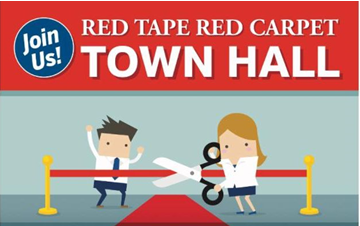 Was this initiative a brilliant Trojan Horse? The Mayor made mention of a committee she was setting up – to be called the Red Tape – Red Carpet (RTRC) initiative during which she, along with her colleague ward 1 city Councillor Kelven Galbraith, were to listen to various groups in the city about their concerns with city hall and the help they needed to grow their businesses.
Lurking in the background was a consistent complaint on the part of the developers and a number of businesses that had found it was very difficult to get anything through city hall in a reasonable amount of time
The RTRC team met with
Rural Business Focus Group, Development and Real Estate Industry Focus Group, Large Business and Manufacturers Focus Group, City Staff and Partner Organization Focus Group, Small Business Focus Group and heard what expected – the departments don’t talk to each other- the agencies (Fire, Education, Region, Conservation) are brought into the picture one at a time.
While Meed Ward was meeting with the various groups – all of which were closed to media – a consistent trait we have noticed from a Mayor who touts her 22 years as a journalist with a high regard for the role the media plays, the Burlington Economic Development Corporation was in the process of looking for a new Executive Director. Anita Cassidy has been serving as the Acting Executive Director for more than a year.
Her predecessor, Frank McKeown, who was at one point Mayor Goldring’s Chief of Staff and went on to run the BEDC, fully understood what the job was – keep the business we have and find new ones – he was just never able to land a really big one.
McKeown thought he was going to be able to put together a partnership with a German consulting group that wanted to get into the North American market. McKeown had his eye on a partnership with McMaster’s DeGroote School of Business and the Fraunhofer Institute for Industrial Engineering – it didn’t work out – the Germans chose Hamilton instead,
Frank McKeown and Mayor Meed Ward never broke bread together – they had strong differences of opinion on what economic development was all about.
 Frank McKeown, asking about how politicians can handle complex issues when voters tend not to be informed and don’t have the background needed to arrive at decisions. Some think that McKeown resigned as head of BEDC when he could see that Meed Ward was going to be the next Mayor. McKeown always did have a good eye for figuring out which was the wind was blowing and whose sails it was going to fill.
While he ran BEDC, McKeown created TechPlace – a location where small start-ups could move in for a period of time and find their footing and then move out of TechPlace and set up shop in Burlington and grow as a new business opportunity for the city.
During this mix of events Mayor Meed Ward got invited to take part in a “Tale of Two Cities” with Oakville Mayor Rob Burton who explained to a good audience at the Performing Arts Centre that economic development should be an in house operation.
There are dozens of business people with tonnes of experience in drawing new business to a municipality that will tell you it is nuts to put that kind of an operation in city hall. Views are clearly divided on that issue.
At roughly the same time Burlington learns that L3Wescam is going to move out of the space they are in on the North Service Road to a new site in Waterdown. The Mayor was caught off guard and had to scramble to put a decent spin on the news.
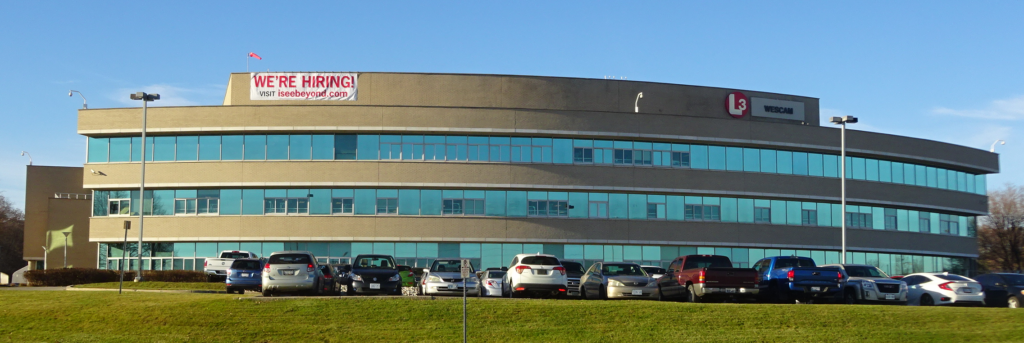 L3Wescam will be leaving these premises for a new purpose built location in Waterdown. It isn’t clear if Hamilton had gotten to L3Wescam and found them a deal they couldn’t refuse; they did that with International Harvester who were all set to move their parts distribution operation from Burlington to Mississauga – then they got a great deal from Hamilton and a time frame that worked for them.
The new Mayor had ideas of her own – she had begun toying with the idea of creating an MDC – Municipal Development Corporation that would be an in-house operation. In the material she prepared she went so far as to describe the job the Chief Development Officer of such an organization would be doing.
“Establish a position at City Hall to act as our Chief of Business Development, serving as a primary outreach for attracting new businesses to Burlington, overseeing and expediting applications through the system and reporting progress and obstacles regularly to City Council and the City Manager
During the July 15th Council meeting- the last one until September the Mayor asked her colleagues to support her idea and move it forward – the support she needed wasn’t there – council deferred the matter to the September meeting when the consultant’s report on the future of BEDC was in hand.
 Anita Cassidy finds herself facing an uncertain future over decisions she didn’t make. One wonders what Anita Cassidy was thinking as she watched this parade of events pass her by.
The city, which provides most of the BEDC budget is current having a study done on what their role should be. As Mayor, Meed Ward sits on the BEDC Board.
Economic Development is critical to the growth of a municipality – some do it very effectively – Welland Ontario is a great example. Others slip and slide around and lose opportunities that they didn’t even see.
The business of attracting a corporation to move to town is really a networking game – you need someone who knows the players, plays a decent game of golf and has a great story to tell.
Burlington has the elements of a great story – parts of which are buried because their value is not perceived.
What isn’t clear yet is whether or not Mayor Meed Ward has the capacity to listen and to surround herself with people who she trusts and will rely upon when it comes to the complex process of how decisions are made. The jury is out on that one – and when it does return it might well be a hung jury.
There is one final irritant – a fly in the soup if you will.
Tech Place has just under five years left on a lease that has a sliding scale of rent increases. In the final full year of the lease rent will be a combination of net rent and additional rent for a total of $301,877 in the 6th year. That is a big nut to crack in anyone’s language.
TechPlace is a program of the BEDC, it has a staff of 1.5 people and an average annual contribution from BEDC’s core budget of approximately $220,000 per year.
Gross rent over the 6-year contract varies from $24,000 in year 1 to an annual cost of $301,000 in the final year.
There is basically nothing in the way of a revenue stream and while there are some bright spots in the Tech Place story it isn’t enough to cover the rent or justify the expense.
In material from BEDC we learn that “TechPlace is a one-stop destination for new and growing technology companies. TechPlace was established to support Burlington’s Strategic Plan 2015 – 2040 that calls for “Innovative, entrepreneurial businesses have settled or developed in Burlington. The city has helped create the technological support, business supports, infrastructure and educational environment to attract start-ups and growing businesses” and to “Create and invest in a system that supports the start-up and growth of businesses, innovation hubs and entrepreneurship.
“Following best in class ecosystem research and stakeholder engagement conducted in 2017 a clear need to have a physical space to build a successful entrepreneurial ecosystem in Burlington was identified to create connectivity, vibrancy and tell our entrepreneurial story. Burlington Economic Development Corporation became the change champion and opened TechPlace to accomplish the City of Burlington Strategic Plan in a way that was aligned with community need and stakeholder input.”
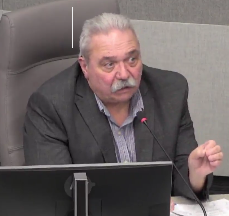 Angelo Bentivegna wanted more information on that Tech Place lease. This is the kind of language developers trot out when defending applications. No one appears to have asked the hard question: How are we going to pay rent of $300,000 in the last year? Ward 6 Councillor Angelo Bentivegna kept asking questions about that lease – bless him for that – no one else was.
“TechPlace is focused on supporting the scale up and growth of high potential companies through its Launch Pad program and a host of wrap around services delivered through partners such as Haltech, Angel One, Mentorworks, Mohawk College, McMaster University and Halton Region Global Business Centre.
“In addition, BEDC has created a “Soft Landing” program to use as a unique business attraction tool that allows companies considering a location in the west GTA to establish a footprint in Burlington and begin operations while BEDC supports their long term business relocation to Burlington through its traditional business support services.”
There is some pretty fancy language in the BEDC material – the results, while interesting, are not going to do much in the way of changing the makeup of the commercial sector in the city.
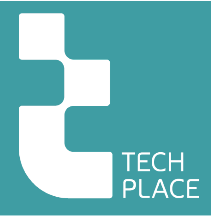 Since TechPlace launched in 2017 it has hosted over 10,000 visitors, 200 events, attracted 13 LaunchPad companies, creating a strong business attraction brand and value proposition for Burlington. Results since inception are: Since TechPlace launched in 2017 it has hosted over 10,000 visitors, 200 events, attracted 13 LaunchPad companies, creating a strong business attraction brand and value proposition for Burlington. Results since inception are:
Total LaunchPads -13
Total LaunchPads from outside of Burlington – 10 of 13 Graduates – 7
Graduates that stayed in Burlington – 5 of 7
The BEDC material adds: “There have been a number of recent changes to the local start-up support ecosystem including the launch of Nuvo Network and the review of the Regional Innovation Centre model by the provincial government including Haltech.
“This creates opportunities for reviewing TechPlace’s operating model and determining whether BEDC delivering TechPlace activities directly or spinning off the activities to a partner can create the same benefits for Burlington with a different operating and financial model.”
“As part of the overall BEDC review, it is worth reviewing the efficiency, effectiveness and optimal structure and mandate of TechPlace to determine the pros and cons of retaining it as part of BEDC or spinning it off to an independent provider. The review would include a cost-benefit analysis of the current investment in TechPlace and what it produces in business attraction, versus other strategies for business attraction (e.g., dedicated staff) that don’t rely as heavily on physical space.”
This amounts to Corporate Spin on a situation that is unraveling quickly.
Is the BEDC signalling that Tech Place has not panned out the way they had hoped and that it is time to bail out?
Ward 1 Councillor Kelven Galbraith was taken on a tour of the McMaster Innovation Park and had this to say: “It was amazing to see the business success stories that have emerged from the park and the continued investment into their facilities and operations.
‘The City of Burlington and Burlington Economic Development Corporation (BEDC) looks forward to a great business relationship with the McMaster Innovation Park in the future”. That train may have already left the station.
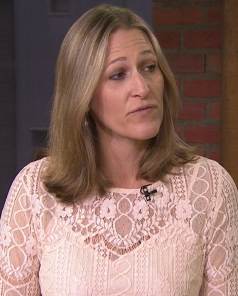 Mayor Meed Ward has a strategy and a long term objective – don’t get in the way. The Mayor wasn’t all that interested in waiting for the result of the BEDC review – she had a job description in her hand for the person who is going to bring some life to attracting new enterprises to the city – all she needed was three of the six votes from her colleagues – they weren’t forthcoming.
Tech Place was seen by former Mayor Rick Goldring as one of his success stories – he really wanted it to work.
Wanting just isn’t enough – is it? The city just might have to suck up that rent cost and look for someone who will take over the lease.
Sean Saulnier over at NUVO One isn’t likely to be the white horse the city needs.
The financial reckoning will take place and a new story line will be spun out of city hall. Burlington learned to leave well enough alone when the New Street Diet proved to be a dismal failure. Are we about to repeat that performance?
Don’t expect to see much in the way of transparency in what happens next – and give up on the idea of holding anyone accountable.
Salt with Pepper is the musings, reflections and opinions of the publisher of the Burlington Gazette, an online newspaper that was formed in 2010 and is a member of the National Newsmedia Council.

 By Ashley Worobec By Ashley Worobec
July 30th, 2019
BURLINGTON, ON
Friday, July 26th marked 100 days until the NYC marathon.
100 days might not sound like much, but it still means more than another three months of solid training.
The goal for me throughout this training is to focus on proper recovery and injury prevention, so I’m doing a lot to support those goals.
I try to get to a yoga class once per week, or do some yoga and mobility work in my backyard. Running inherently tightens everything up, and I feel like my muscles and joints move better if I continue to focus on mobility – it only takes a few minutes to see the benefits, and I really advocate this under-utilized component of athleticism to all of my patients.
 The general rule is that dynamic stretching (stretching that involves movement, like walking lunges, marching and leg swings) is best to be done before activity, whereas static stretching (stretch and hold movements, like the downward dog seen in my photo) is best to be done after activity. The general rule is that dynamic stretching (stretching that involves movement, like walking lunges, marching and leg swings) is best to be done before activity, whereas static stretching (stretch and hold movements, like the downward dog seen in my photo) is best to be done after activity.
 I am also really trying to focus on sleep, and that 9 hours you see on my Garmin reading happened the night after a 20km run (my longest run to date in this training plan). I am also really trying to focus on sleep, and that 9 hours you see on my Garmin reading happened the night after a 20km run (my longest run to date in this training plan).
Sleep is when our body rebuilds itself, and since marathon training is so catabolic (breaks down muscle), sleep helps to rebuild that damage and repair stressed tissues.
My long run will build up again this weekend to 22km, and then I’ll have a recovery week of a 16km long run- this method of a few weeks of mileage buildup, followed by a recovery week where mileage is decreased, is called “periodization of training,” and it is used across many training domains, including running and weight-lifting.
RECOVERY is key, you cannot expect your body to just do more and more and more without giving it a break periodically.
Another important component of my training right now is building leg strength and power, and this is done with hill running (trills, or trail hills, as noted below).
Although the NYC Marathon route is not known for it’s hills, the number of bridges (and therefore bridge ascents) that we have to cross is deceiving, and there is 10km of ascent throughout the 42.2km route!
Hill training, and the benefit of leg strength, is very important if I’m going to make it up those bridges.

 By Staff By Staff
July 30th, 2019
BURLINGTON, ON
This afternoon, on Tuesday, July 30, 2019, at 2 p.m. City of Burlington aquatics staff noticed an odour.
Staff cleared the pool and evacuated approximately 40 people outside the pool and splash pad perimeter.
Staff called 9-1-1 and fire, ambulance, police and the health department responded at 2:13 p.m..
 The facility at LaSalle Park is very popular. Eighteen individuals were assessed on scene and seven people were transported to hospital for further evaluation.
It has been determined that during routine maintenance, water levels had dropped causing disinfectant to enter the pool at higher than normal levels, but still within the recommended range. The levels have since been further lowered. The City is reviewing this incident to prevent future incidents.
The Burlington Fire department inspected and tested the entire perimeter of the pool for air quality and deemed all levels to be safe.
At this time, the Halton Region Health Department is on scene. The wading pool and splash pad will reopen once approved by the health department. The City expects to reopen the pool tomorrow at 11 a.m. once it has been tested, inspected and confirmed safe.
The above is the city’s story – and they will stick to it until an independent authority takes a closer look and asks some “why’s” about how disinfectant levels are determined.

 By Staff By Staff
July 30th, 2019
BURLINGTON, ON
A devoted Gazette reader popped us a note. “You might want to read this over and perhaps share it.” The article, which is rather long, is on the value (or lack thereof) of public engagement.
Ruben Anderson wrote the piece on August 6, 2018. He mentions an article with the headline – “Most Public Engagement is Worthless” which he said grabbed his attention.
That article launched Anderson’s thoughts.
“I think most public engagement is beyond worthless. I think it actually corrodes the relationships we need in order to build a strong town. Most public engagement, as it is currently conducted, makes our cities worse places.
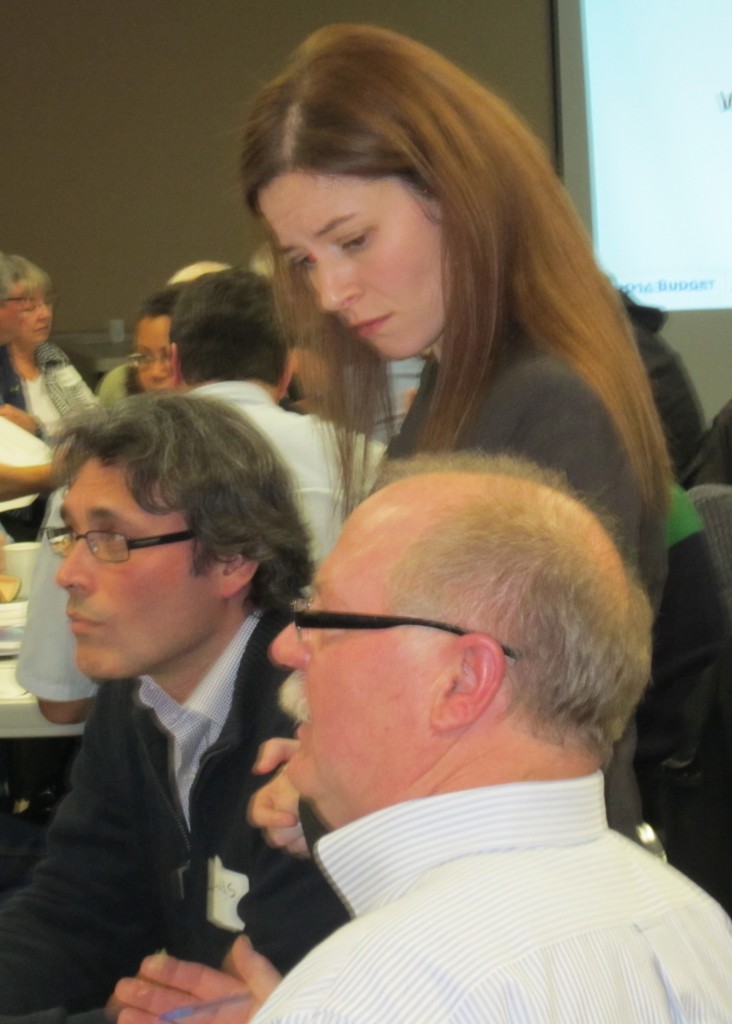 Finance department staff explaining a part of a budget during a public forum. “Does this mean that I am saying we should abandon public engagement? Most definitely not. But I think we need to understand behavior, relationships, and expertise a lot better if we are going to do good with our consultation efforts instead of harm. Public engagement needs to be done well, because it would be better to do nothing at all than to corrode the public’s trust in City Hall and in each other.
Let me tell you a story.
I was working for the City of Vancouver’s Sustainability Group and was assigned to a large urban planning process. Consultation was said to be critical, necessary, jugular—and so we dog-and-ponied with our flip charts and sticky notes and dotmocracy.
We asked people the question, “How could Vancouver be more sustainable?”
Solar Panels! they told us. Windmills! Plant trees! Ban plastic bags! Ride bikes!
Golly. Solar panels?
Here I am working in a Sustainability Department and I never thought of solar panels. How could I have missed that? Solar panels! And bikes? Wow. Just wow. What a fool I was! My eyes are opened!
What I am trying to describe here is how terribly insulting this process was to everybody involved.
We had asked a question that could produce nothing but disrespect for the experts who have dedicated their education and careers to reducing environmental impact. Of course we knew about solar panels.
And we had asked a question that the members of the general public were not equipped to answer, because they aren’t experts. There are some good reasons why solar panels are not installed faster—it is almost always a better idea to insulate your home, weatherstrip and draught-proof first. You reduce your own energy demand before you put on solar panels.
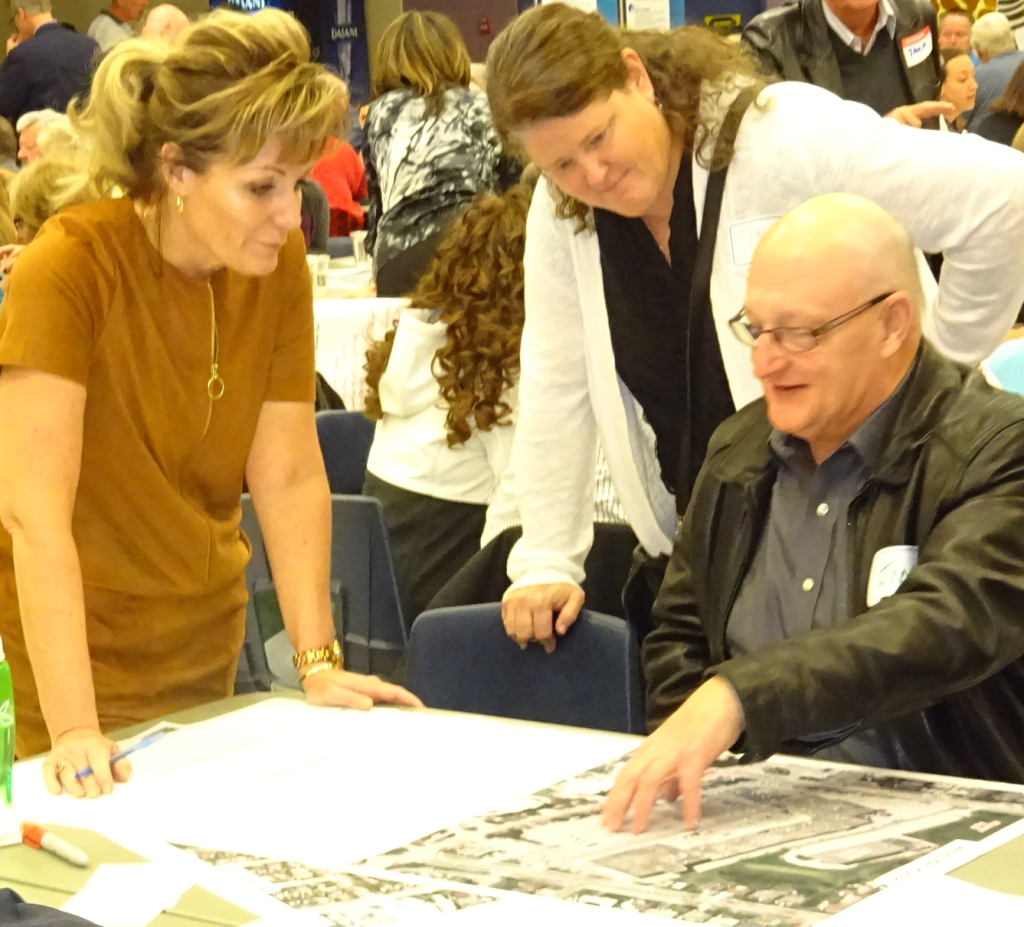 Jennifer Johnson on the left listening to a residents ideas at Lakeside Plaza visioning exercise. When the report and recommendations come out, the public sees nothing that resembles what they asked for—they wanted solar panels and they got weatherstripping. They too feel disrespected. They gave their irreplaceable time, hours from their one and only life, and look what they got.
They had to give something up in order to come to the consultation, and nothing good came of their time because they weren’t asked questions they could meaningfully contribute to answering.
This is not how you build a trusting relationship: a strong foundation on which to work together. This is how you corrode trust.
Another story: the city I now live in, Victoria, BC, recently began installing “all ages and abilities” bike lanes after a significant consultation period. At a couple of the consultations, big maps were laid out so people could draw where they thought bike routes should go.
If you’re having the public draw bike lanes, think about why. What expertise do they have that your bike planners don’t?
 Does the clearly coloured bike lane make it safer? Only if car drivers are aware of why the colouring is in place. To be quite blunt, if your bicycle transportation planner does not have a very clear idea what routes would balance geography, access, cost, safety, behavior change, etc. then they are incompetent and should be fired.
If your planner is not incompetent, then they are probably well-read on the past couple of decades of practical experimentation with bike infrastructure. They probably know the current best thinking on the sorts of places bike lanes should connect and serve. They have probably seen a hundred examples of creative solutions to integrating bikes into cities. They have been paid by the city to learn these things, and probably have done a bunch more research on their own because they are transportation geeks.
So the public was asked to come in and draw routes. The public doesn’t know anything about how many dollars per kilometer each option costs. They don’t know about lane widths, and how wide the city right-of-way is. They know nothing about other things that may be important, like planned changes in sidewalks, utilities, and developments.
We ask people who have none of the education, experience or knowledge needed to make proper decisions to come in and draw routes, and we ask the City staff to sit there and be polite at the ridiculousness that pours out. Can you imagine how the staff feel about giving up their evening with their family, after a day’s work, to go be polite to people who are unaware of virtually all the limiting factors?
And so the public input is ignored, which in this case is the right thing, and the public feels abused, disrespected, undervalued and duped, which also seems like the logical outcome of the consultation.
What Are We Trying to Do?
I really mean this question. What are we trying to do when we do public engagement?
Why are all these people in this room? What are we trying to accomplish? Before we gather people for public consultation, we need to be clear and honest about what we are trying to do. Then, if consultation is the right solution, we can design a process to fill that need.
Are we trying to get ideas?
Our culture loves Ideas! We have Idea Jams! Idea City! TED Talks!
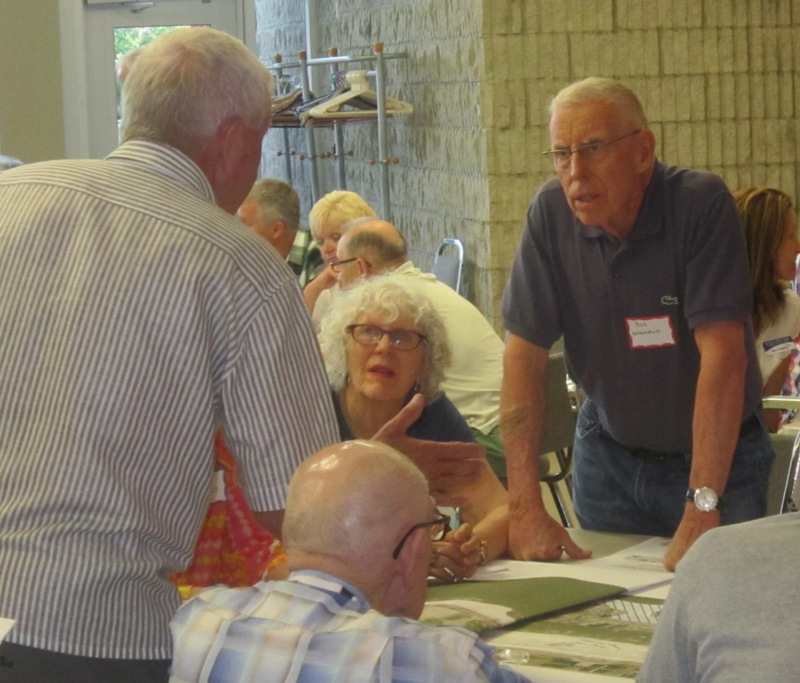 Bob Wingfield, a long time Burlington resident differing with former ward 4 Councillor Jack Dennison. Lack of ideas is almost never the problem, as I have argued elsewhere. The problems we face are usually a lack of social cohesion or a lack of money—and a lack of money often also indicates a lack of social cohesion; not enough people care about the project to tolerate a tax increase to pay for it.
Even if we did need more ideas, consultation doesn’t work to generate them. I have a degree in Industrial Design, so I actually took classes in generating ideas. As a working designer I had to constantly generate new ideas. I can tell you, there is not much of a worse way to generate ideas than to put a bunch of strangers with competing interests who are untrained in brainstorming techniques into a room for three hours.
Are we trying to build social license?
Superficial exercises like dot-voting often fail to respect and take advantage of the expertise of either professionals or the public, and leave both feeling insulted. (Image source: Wikimedia Commons)
Maybe. One of the knee-jerk responses every planner is familiar with is “There was no consultation.” So, putting out a plate of stale cookies and setting up a sad dot-voting exercise neuters that response. Maybe there was nothing consultative about it, but the sign in the hall said “Public Consultation This Way,” so I guess there must have been a consultation.
Bringing many people with different goals together behind one project is quite a big task. Clearly a real program to build social license would take a lot more time and care than your average public meeting. Planners know how to hold value-based discussions, but I don’t know that I have ever seen them use that skill in the processes I have been involved in.
If you need to build social license, maybe you should throw street parties; have a barbecue.
Are we trying to acknowledge people?
I have come to think that engagement tries to acknowledge the public’s plaintive cry, “Don’t forget me.” I think people often don’t need to win; they just don’t want to be forgotten. But as I described above, the outcomes of our processes sure look like they were forgotten.
I wonder what it would be like if the design team went through the plan inch by inch, narrating the compromises, costs and failures, the choices they made, and the specific comments from participants. “Albert and Ruth, who live in Fairfield, are concerned that we expand the songbird habitat. We did that by specifying different landscaping from the typical pom-pom tree and grass lawn. The west side is a native plant garden, intended to be wild and seldom entered by people.”
Are we trying to let off steam?
Issues sometimes get contentious, and letting people vent and feel heard seems like a valid goal—it is just that our public meetings often seem to do the opposite. They actually increase tension instead of releasing it. How could we vent most effectively? Could we play dodgeball? I mean literal dodgeball, where we try to smoke the people we disagree with as hard as we can with a fast-moving ball.
I understand that dodgeball does not resolve what we think of as city planning issues—but neither does the current model of public consultation. And the current model often increases tension between parties, whereas at least dodgeball would dissipate some of it. So there is a very real, serious case to be made that dodgeball would produce better outcomes from our consultations than any amount of sticky notes and dotmocracy ever will.
That is a sad commentary.
Misplaced Expertise
It is clear the public is dissatisfied with much public engagement, and do not feel they were actually listened to.
In the Facebook comments on Chuck’s article, Nancy Graham said “A lot of [consultation] is simply for show and to pretend you are being heard when the leaders have already decided the results they want.”
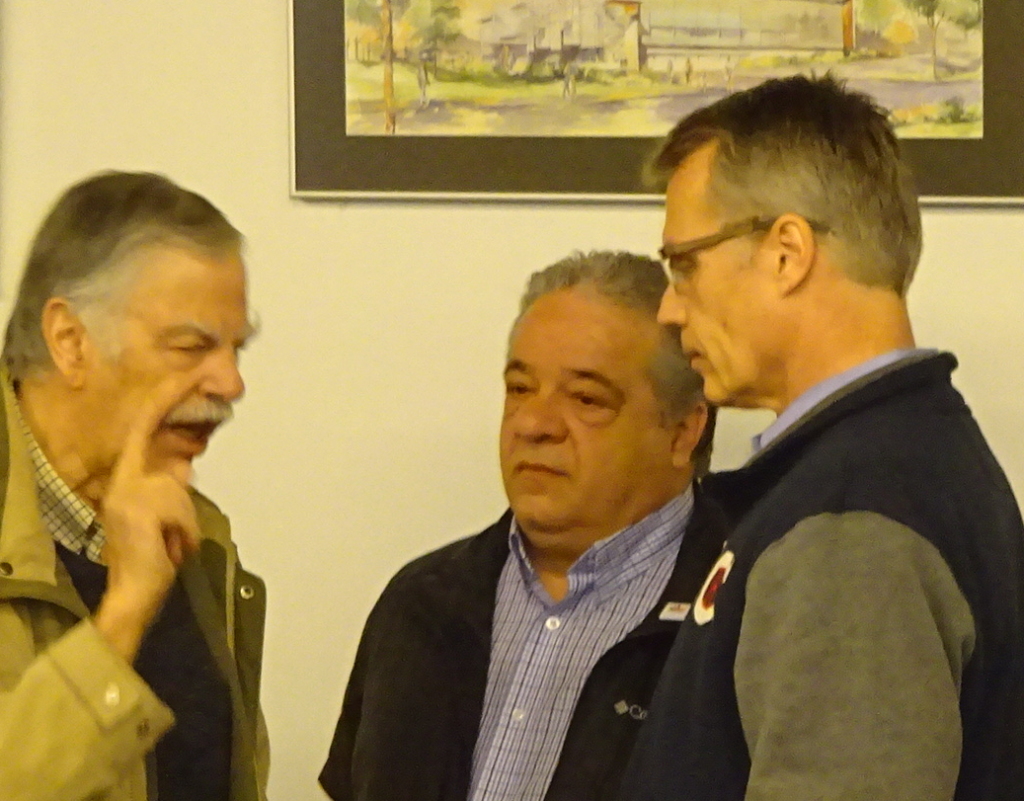 An unhappy transit user letting Director of Transportation and former Mayor Rick Goldring know what he thinks. Why would leaders do what they want? Sure, maybe for self-interest and personal profit in some cases. But perhaps it’s generally because they think they know better and are trying to make the world a better place. This belief is not unfounded; presumably, they have years of education and on-the-job experience and privileged knowledge of the tricky terrain of this particular troubling issue.
Expertise is unfashionable right now, partly because our society is not very good at understanding who is expert at what, so we give too much power to some people and not enough power to others.
One of the most enduringly popular Strong Towns articles is Chuck’s Confessions of a Recovering Engineer, in which he lambasts his younger self and his former profession in rich detail. He describes how he would arrogantly ruin neighborhoods and destroy streets, thanks to his confidence that his asphalt was for the better. He was the expert.
He was an expert in engineering, who ruined the place. Citizens were promised something better, but what they got was something worse.
And most of our cities have many Chuck 1.0s. Many of us live in cities that were impaled with freeways through the core. We travel on streets that are unsafe by design. The sense of place does not show up in engineering standards manuals.
And yet it would be silly to break out the dotmocracy to specify how to repave a road. It doesn’t matter how you feel about finely crushed rock compacted in the base layer; it matters how it performs with vehicles on it.
Engineers should be expert in the strength of materials and construction methods. They are in no way expert in human behavior, nor are they experts in public opinion. They should not be making political decisions or urban design decisions.
The engineer’s role, which has grown to have so much influence in so many cities, should really be quite technical and fairly powerless. They should have the job of implementing decisions made by others, and within that, their expertise for materials and construction should be completely respected. They are the experts at that.
Sadly, we don’t see residents as experts. This is a critical and corrosive mistake. Of course, they certainly are not experts in how to reduce greenhouse gases, or pave roads, or pick bike routes. They should not be picking beams for a bridge.
But citizens of a city do know how the built environment makes them feel, and how they would like to feel.
They are experts in how increasing taxes will stress them out. They are experts in hidden secrets of their streets and alleys. They are experts in the amenities they want for themselves and their family. They are the only experts.
Their expertise should be respected.
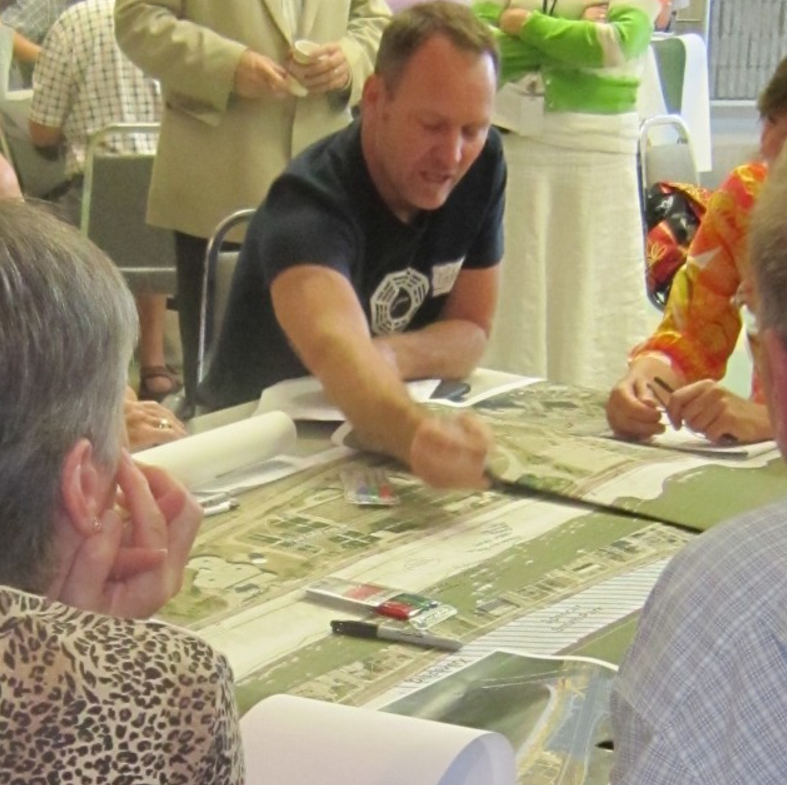 Beachway residents looking at early maps “We should only consult with residents when they are the ones that can best answer the question at hand. But in those moments, they should be treated as the experts they are.”
One of the most impactful examples of this I have seen comes from when Oregon had single-payer medicine and was trying to ensure tax dollars were spent most effectively. Experts rated every medical procedure and pharmaceutical by its cost and the quality of life it gave, then ranked them from best to worst. Right up at the top was treatment for pneumonia, and at the bottom was life support for babies born without a brain.
And then they added up the medical costs and the current tax revenue, and drew a line on the list where the tax dollars ran out.
Medical experts made the list of treatments. And then residents—experts in the impact of sickness on their family and community, and experts in their personal budget—got to decide what should be covered.
Essentially, the public got to choose how many people would die. Would you like to cover more procedures? Simple, just pay more taxes. Should we spend one million dollars per year keeping an 80 year-old alive? Nope.
And so the line is adjusted.
What Chuck describes in “Confessions of a Recovering Engineer” is that the choice of how many shall die on our roads has been delegated to engineers, who prioritize speed over life. That is wrong. Engineers are not qualified to make that choice. Only the citizens are experts in how many funerals they would like to attend each year, and how much tax they are able or want to pay—and it turns out they prioritize safety over speed.
So far I have talked about engineer experts and resident experts. But in his latest article, Chuck also talked a lot about design, referencing Steve Jobs. In fact, commenter Kevin Adam noted the similarities between Chuck’s article and corporate Design Thinking.
As I mentioned, I have a degree in design and worked as a product designer—so naturally I think design is incredibly important. Designers bring a different expertise to the equation that residents and engineers typically don’t have.
The old joke about the iPhone is that if you asked people what they wanted in a telephone, they would have said, “Longer cords.” That is the product of a worthless consultation.
So to avoid that, Chuck says, “get on with the hard work of iteratively building a successful city. That work is a simple, four-step process:”
Humbly observe where people in the community struggle.
Ask the question: What is the next smallest thing we can do right now to address that struggle?
Do that thing. Do it right now.
Repeat.
Let me reframe this list as a design process.
1. Humbly observe where people in the community struggle.
Almost every word here is pure gold so I am going to break it down.
Humbly…
Arrogant, rock-star designers may be fine for chairs or blenders, but as I have already said, only the residents are experts on living in their city. To get good outcomes, the designer must approach with humility, in service of the city and its people.
…observe…
Asking people what they want is often very ineffective. Most people aren’t trained to imagine seemingly impossible things, like a stylish supercomputer that fits in your pocket.
Good public opinion pollsters have to distill opinions out using oblique questions and the discernment that comes with years of experience. Angus McAllister, CEO of McAllister Opinion Research, said, “Most consultation and opinion research is like eating a Big Mac—empty, unhealthy and dissatisfying.
Humans are poor at noticing the drivers of our own behavior. We often behave for one reason, and then seek an explanation for why we acted that way. Typically we just pick something reasonable-sounding even if it is totally unrelated.
For example, if you ask someone why they come to a certain café, they may respond that it has lots of parking. So, if you remove the parking and they keep coming, you know parking is a post hoc rationalization. In fact, they like the way the light falls on the patio, or the service, or the smell reminds them of their grandparents’ kitchen.
Changing the parking is a design prototype. Nothing happens? Change it back and do something different. It is not just whole projects that need to be iterative; the stages within a project also benefit from iteration.
So good designers have to ask lots of careful questions, but observing behavior is critical. You can ask people what route they walk, but when you observe the paths worn through the grass, you have real data.
…where people in the community struggle.
We hold up Gods of Technology like Elon Musk and Mark Zuckerberg, but they are solving their own problems—rich tech bro problems. They don’t care about sidewalks or corner stores; they have driverless cars and drone delivery!
2. Ask the question: What is the next smallest thing we can do right now to address that struggle?
A Strong Towns principle is that it is less risky to make many small bets than one huge gamble. It is also often strategic, because it is much easier to get permission to do a small thing.
From a design perspective, it is easier to manufacture a spoon than it is to build a kitchen mixer with hundreds of parts—but both can whip up a cake.
3. Do that thing. Do it right now.
Actually, before you do the thing, I would like to add one more step.
2b. From a design perspective, it would sure be awesome if you would collect some data first, to test your Theory of Change.
Here are some Theories of Change:
If we paint a bike lane here, more people will ride bikes.
If we narrow this road, cars will drive slower.
If we widen this highway, we will eliminate congestion.
So, when we plan our interventions, we are using a Theory of Change—whether we have stated it or not—and it is important to collect data to test your Theory of Change.
Collecting data can be very tricky. For example, if you stripe a bike lane, you may see more bikes on that road. Are they new cyclists, or did the same old cyclists just change routes? If your goal is more cyclists, that matters.
So, collect data that will actually test your Theory of Change. As far as I am concerned, the number of hits on your website is generally useless data. We want to count real world change.
3. NOW you do the thing.
Do the thing, then observe. What actually happens in the real world? What do people do—not what do they say, what do they do? Do they drive slower, ride more, shop locally, add a basement suite, plant a tree—whatever. What do they do?
This lesson is one of my favorite from design school. What people do is the only measure that matters. My teacher said, “The users tell you what your design is.”
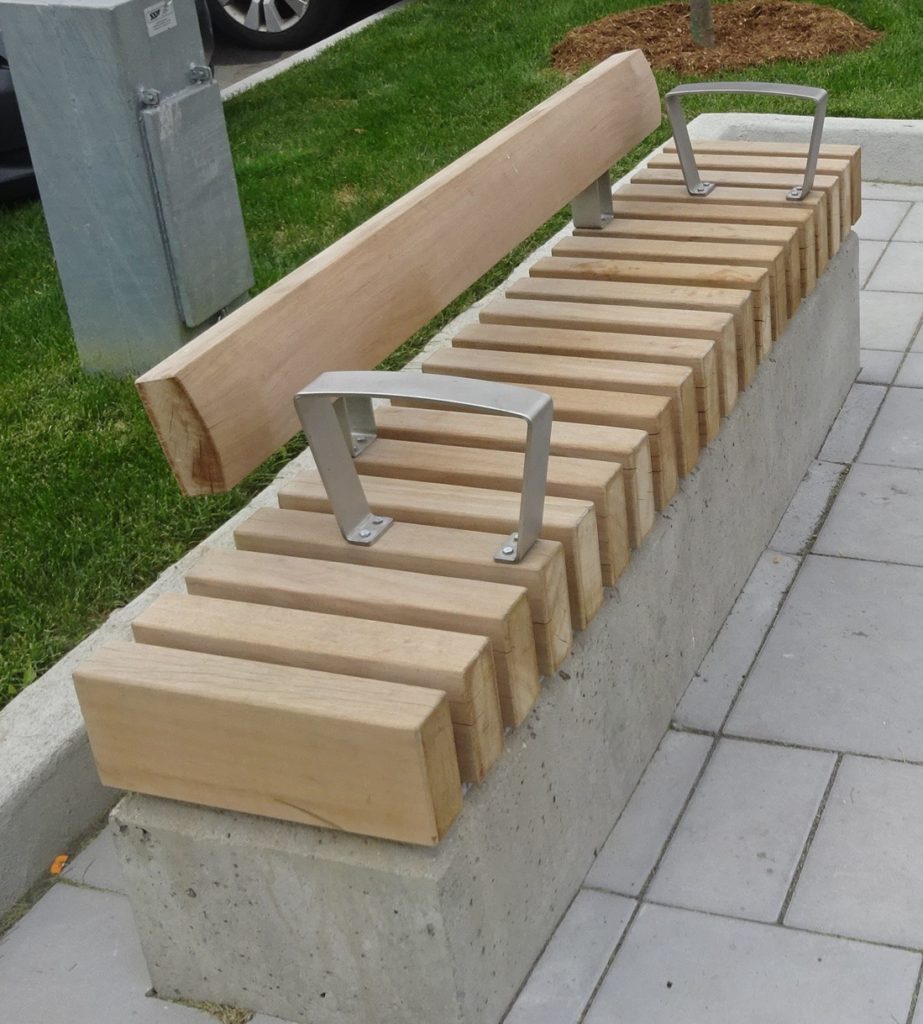 Did the public have any input in the design of this bench. Did the people who approved the design every sit on the bench? Imagine you have designed an amazing bench—but nobody sits on it. The skateboarders, however, love it.
Well, then you have not designed a bench, you have designed a skate feature. It doesn’t matter what you think you are designing, it matters how people use it.
I hope you find this to be liberating. If you are struggling with a doorknob, or a toaster, or a sound system or your car’s windshield wipers, it is not your fault, it is just bad design. Bask in this insight while you scroll through Gracen Johnson’s sad collection of design failures, #PlacesIDontWantToSit.
So collect the data, and compare it to your Theory of Change. Did it work, or is your theory garbage? If it is garbage, it is a relief you only made a small bet.
4. Repeat.
“Good designers have to ask lots of careful questions, but observing behavior is critical. You can ask people what route they walk, but when you observe the paths worn through the grass, you have real data.”
Collect data and observe the results, because it is a drag to keep repeating the same mistake over and over again. Watch what works, and repeat that.
Now, in this list, consultation just disappears, and I think that is a bit hasty. I think the design experts should humbly observe where the community is struggling—but where do you start observing?
 Blowing off steam – certainly not communicating. This is when you ask the experts. Consultation can map hot spots. Consultation can prioritize which hot spots to address first. If you need to know how it feels to live in a city, where the friction points are, and what is most beloved and cherished, residents are the only experts. Design a consultation to harvest their expertise, and then act on what they give you.
Consultation is a very small part of the overall process, but can be useful and important.
We need to be more aware of different kinds of expertise, and who has it. Each expert—engineer, resident, or designer—only specializes in a narrow field, and we mustn’t ask them to do each other’s jobs.
Otherwise, we disrespect everybody involved, and we corrode goodwill and trust on all sides.

 By Pepper Parr By Pepper Parr
July 29th, 2019
BURLINGTON, ON
Despite a year of significant upheaval in the Planning department – staff are now working on several critical reports with tight time frames – and developing ways to include the public in the process on an ongoing basis and not when it is all wrapped up.
Planning staff are well into the Work Plan for the scoped re-examination of the Adopted Official Plan.
It is a mammoth task that has to be done right if Mayor Marianne Meed Ward is to meet the mandate the public gave her in October.
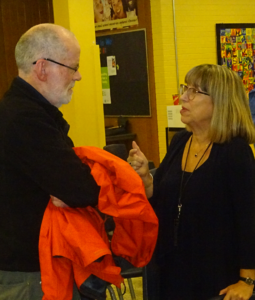 City planner, Heather MacDonald , on the right, in conversation with Blair Smith The Planning and Development Committee set out what the Department of City Building is expected to get done during the summer.
Along with the re-examination of the Adopted Official Plan the City Building Department has to figure out just what they want to allow in the way of development in the city core – now that there is a freeze on all development in the core.
Direct the Director of City Building to proceed with the work identified
Direct the Director of City Building to propose refinements to the Neighbourhood Centre’s Policy to simplify and clarify the intent of the policies, generally described in section 4.2.3; and
Direct the Director of City Building to modify the terms of reference upon confirmation of impacts related to Bill 108 and other Provincial changes to the land use planning and development system, if required.
All this began when city council adopted a new Official Plan. That plan was sent to the Region which is the approval authority for the Official Plan.
On December 4, 2018, the day after the new city council was sworn in, the Region of Halton provided a notice to the City advising that the adopted Official Plan does not conform with the Regional Official Plan in a number of respects. The effect of the notice extends the Region’s review process indefinitely, until such time as the Region determines that the non-conformity is rectified. The supporting information identified that:
The City of Burlington can make additional modifications before the plan is approved by the Region where there is appropriate planning justification and public consultation. Any modifications would need to be assessed for conformity against the Regional Official Plan and Provincial Plans and policy statements.
 The night the election was won. That statement gave the new Mayor a free hand to look at everything in the plan that had been adopted by the previous council despite considerable opposition to the plan from a large portion of the public.
In February, 2019 Council provided a staff direction to re-examine the policies of the adopted Official Plan:
Direct the Director of City Building to immediately commence a process to re- examine the policies of the Official Plan adopted April 26, 2018 in their entirety related to matters of height and intensity and conformity with provincial density targets.
A Council workshop was held on March 18, 2019 to obtain further Council feedback on this direction, which has resulted in the scope of work.
To prepare for the Council Workshop, a series of meetings with Councillors were undertaken. The result of these meetings was a list of issues relevant to each Councillor, which informed the preparation for the Council Workshop.
A number of key themes emerged from the workshop discussion. It was clear that Council agrees that the work identified should be completed by the end of Q1 2020. That is eight months away.
Through discussion at the workshop it was agreed that the adopted Official Plan brings in new policies and forward looking approaches to land use planning and growth. In general, Council supports the majority of the policies within the adopted Official Plan.
Two key areas emerged as requiring further consideration: the Downtown Precinct Plan and the Neighbourhood Centre policies.
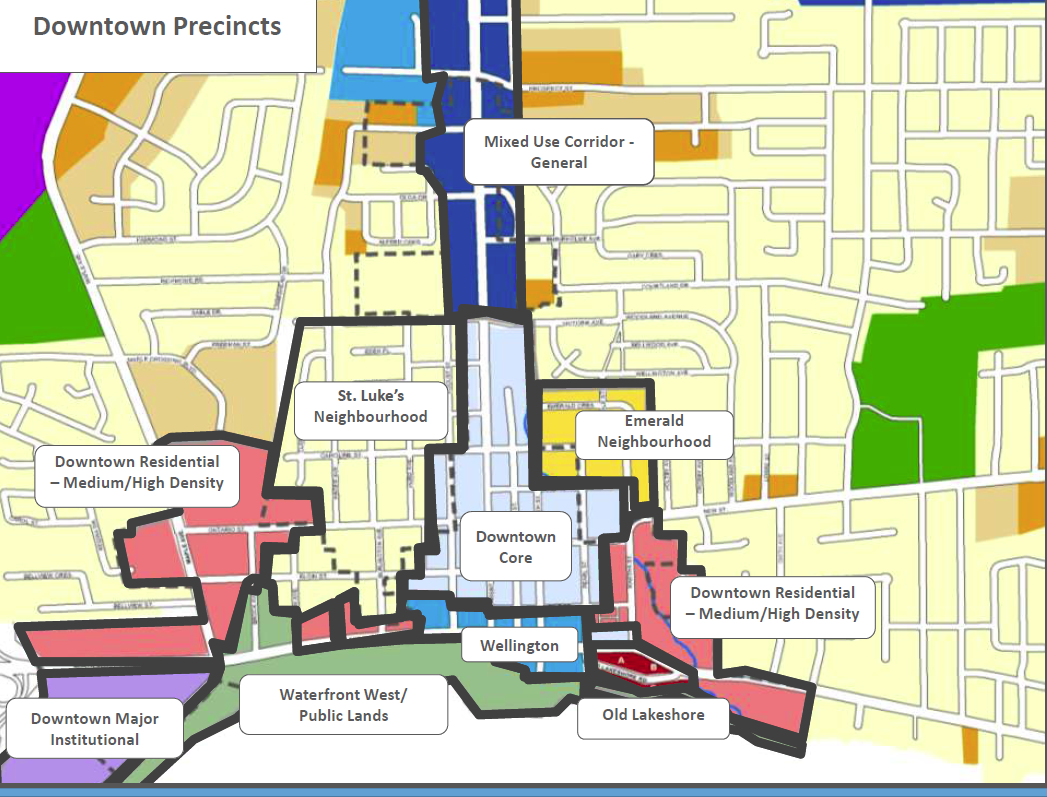 A precinct is not limited to a single given area: it is rather a description of what can be done in an area within the named precinct. It was acknowledged at the workshop that the Official Plan is not intended to provide detailed land use policies for specific sites. As a result there is a role for more detailed land use planning processes. These processes can include both detailed, city-led area specific planning exercises such as area-specific plans, or site-specific development applications for Official Plan and/or Zoning Bylaw Amendments.
Coming up with an Official Plan that could be defended has never been a slam dunk for Burlington. Almost everything they do gets challenged – costing the city a bundle in legal fees and months of work time dealing with the appeals.
To this end, staff and consultants will need to work together to prepare modifications to policies, based on technical information and public and stakeholder input, which demonstrate the functionality and feasibility of a recommended scenario in conformity with the Regional Official Plan and Provincial Plans and policy statements.
It was no surprise to anyone that throughout all the questions and discussions at the workshop was the role community would play – this council was elected to ensure that the community was at the table.
The results had to be reflective of the community’s vision for the future of Burlington;
– Be that residents believe that the Official Plan represents their values for the future of the City;
– Be supported by an effective public engagement process; and
– Be supported by the public.
Staff agree that the work to re-examine the Official Plan must be supported by a public engagement process and a decision-making process that all stakeholders can understand and agree to in principle. As identified generally by Council, this need for public satisfaction of the plan must be married with the desire to develop a plan that is defensible from a land use planning perspective.
In order to achieve success the project team must transparently:
– educate and communicate the givens – the plan must conform to provincial policy.
– identify the questions that are in scope and out of scope;
– collect, analyze and respond to the feedback;
– use the best tools possible to communicate alternatives, short and long-term impacts and their associated benefits and drawbacks;
– describe and continually communicate about decision making processes; and,
– identify process challenges along the way.
It was this need to ensure that the public was informed while the changes were being made and not have a finished plan introduced to an unsuspecting and unaware public that brought out the need for the creation of a communications plan that had input from the public – people sitting at the table with the planners. A major new step for Burlington.
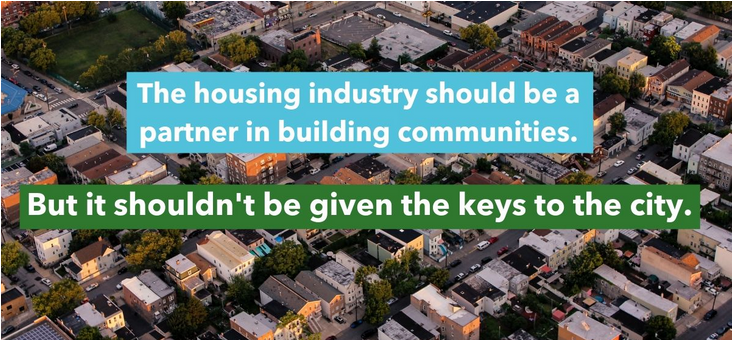 Bill 108 was not only contentious because of the content but also because of the speed with which is was introduced and made law. Hovering in the background is the impact of Bill 108 which some have described as a Developers Dream Bill. WeloveBurlington provided an excellent over-view of the Bill and its probable impact. Add to this the Provincial Review which is looking at what form the Regional governments will take going forward.
The Strategic Plan, which has up until now been a list of high level values that everyone subscribes to with there being not very much in the way of detail.
Burlington took a different approach – they took the Strategic Plan “vision” and made it the front end of a series of objectives known as V2F – Vision to Focus. There is a detailed list of where in the Strategic Plan this council thinks the focus should be place.
V2F has been labelled “living document”; one that will undergo changes daily if necessary.
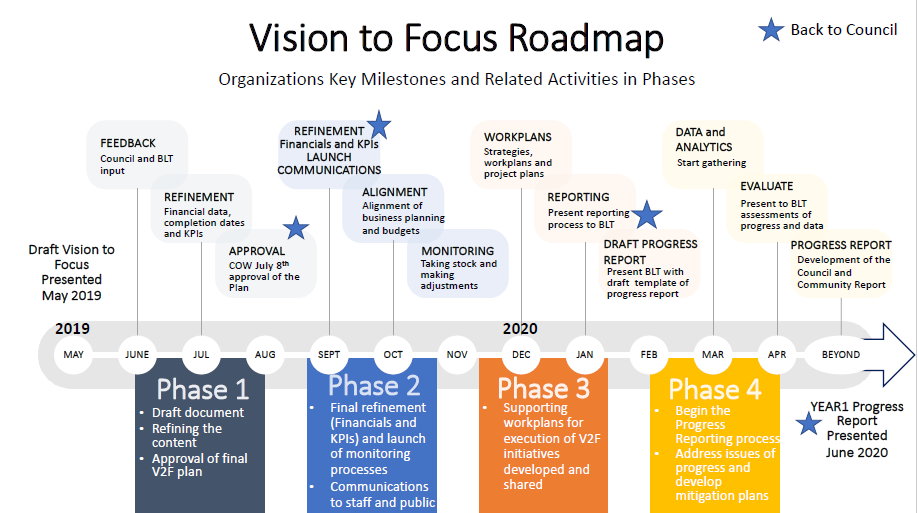 It was another new move on how council was going to proceed and keep the public in the loop. Problem now is for the public to keep up. While all this is going on council has to deal with a number of related high priority initiatives that are identified in the Official Plan and the Strategic Plan such as the Mobility Hub Area Specific Plans and the Housing Strategy.
Tucked in there is the budget this council wants to have in your hands before Christmas.
These Housing and Mobility Hub initiatives have been postponed given Council’s focus on the re-examination of the Official Plan and the Interim Control Bylaw Land Use Study as well as the work addressing areas of non-conformity of the adopted Official Plan with the Regional Official Plan and given the uncertainty related to the Region’s Official Plan Review.
The March Council Workshop identified two key areas of the Adopted Official Plan that must be included in the scoped re-examination of the adopted Official Plan to guide the next year of work:
a modified precinct plan for the Downtown Urban Centre;
and a review of the Neighbourhood Centre’s policy.
In order to get a solid grip on just what the scope of work was Planning department staff had to be fully conversant with what came out of the March Council workshop; the Motions related to the Downtown Urban Centre that were not passed during the adoption process; the non-Official Plan related Council directions identifying issues to be considered through the Downtown Area Specific Plan; the Commercial Strategy Study recommendations related to the Downtown, with specific attention to small scale retail in the downtown; and the details of Interim Control Bylaw Land Use Study.
This is no small matter.
The Downtown Precinct Plan in the adopted Official Plan was based upon a vision at full build out. Council wanted staff to look at a shorter planning horizon which resulted in a modified precinct plan for the Downtown Urban Centre that would have a planning horizon of 2031, in conformity with provincial policy.
The population and employment forecasts contained in the applicable upper- or single-tier official plan, that is approved and in effect as of July 1, 2017, will apply to all planning matters in that municipality, including lower-tier planning matters where applicable.
The background technical work prepared to date for the Downtown area-specific plan, to be finalized through this study, will confirm development constraints and provide clarity on infrastructure capacity and required improvements.
The shift of the scope of this work to the 2031 planning horizon means that there are not likely to be significant infrastructure issues identified through this planning exercise.
The next planning horizon is 2041.
The planners would just like to get what they have in front of them done within the very tight timelines.
The outcome of this work will not constitute an area-specific plan, instead the outcome will be modified policies which will go beyond the high level Official Plan policies that are included in the current adopted Official Plan (April 2018). The modified policies will be developed to ensure that the City can conform with the Growth Plan policy to accommodate 200 people and jobs per hectare combined within the Urban Growth Centre boundary by considering the findings of technical work and public, agency, and stakeholder feedback.
What is going to get a very close review are all precincts within the Downtown Urban Centre where significant concerns regarding height and density were raised by the current Council;
– All precincts impacted by motions not passed when considered by the previous Council in the development and finalization of the adopted Official Plan;
– Specific policies identified to be modified based on the technical work;
– Small scale retail in the Downtown;
– Built form transition to adjacent residential areas;
– Heritage conservation and cultural heritage resources;
– Flexible streets
The Proposed Terms of Reference do not address:
– Shifting the Urban Growth Centre from the downtown to Burlington GO. The Urban Growth Centre location is established in the Growth Plan for the Greater Golden Horseshoe and the Region of Halton Official Plan. Any policies proposed for the Official Plan must conform with both;
– Major Transit Station Area and Mobility Hub role and function in the downtown as they will be considered in the Interim Control By-Law Land Use study and recommendations will inform this study;
– Transportation or infrastructure assessments to support people and jobs beyond 2031.
– Undertaking a Neighbourhood Character Area study for the St. Luke’s and Emerald precincts. Matters of zoning in the St. Luke’s and Emerald precincts will be considered at the time of the Zoning By-law Review;
– The Old Lakeshore Road Precinct. This area requires a more detailed area specific planning process as identified by adopted Official Plan policy. For more details see Appendix B;
– The Waterfront Hotel Site. This site is subject to a process outlined by a Memorandum of Understanding signed by the City and landowner. For more details see Appendix B;
– Revisions to the Downtown Public Service Precinct. It is expected that the development criteria and other policies of the adopted Official Plan provide sufficient guidance for development in the precinct; and,
– Developing parking rates for the Downtown. Parking rates for intensification areas such as the Downtown are to be addressed through the preparation of site-specific zoning.
Interest was expressed in having the Neighbourhood Centre policies in the adopted Official Plan reviewed.
The role of policy in supporting the redevelopment of Neighbourhood Centres is to establish a detailed policy framework to guide the consideration of site specific development applications. Consistent with the Strategic Plan, the policy framework encourages redevelopment of plazas.
Staff has considered the discussion at the Council Workshop and acknowledge that there is an opportunity to simplify and provide further clarity related to the intent of the Neighbourhood Commercial policies and their relationship to the Strategic Plan. This will be led by staff and would be implemented as part of the proposed modifications to the adopted Official Plan. This work will include:
– Identifying opportunities to clarify and describe the intent of the policy;
– Simplifying language; and
– Clarifying the relationship of the land use policies with the growth framework.
The scope of work proposed has a one-year time frame which was identified as a critical success factor. As discussed at the Council Workshop held on March 18th, another consequence of proposing work that would extend the time frame beyond March 2020 is primarily to shift out the initiation of work for a number of planning studies or initiatives by 12 – 18 months.
When all this was being worked out Bill 108 was not yet the law of the land. Now it is. The Province has also released a new Growth Plan and Provincially Significant Employment Zones Mapping.
Funding of $600,000 from the Policy initiatives reserve fund was approved as part of the 2019 budget for Official Plan related initiatives.
While all this work is taking place a group has been meeting with citizen groups to determine how all this complex information can be put before the public on an ongoing basis. The Gazette wrote about that work in an article last week.
Related news story:
Engagement with the public on a much different and highly desirable scale is taking place during the summer.
You have lost control
Weloveburlington on Bill 108

 By Lynn Crosby, David Myers, Deborah Ruse, 0Blair Smith, Josie Wagstaffe By Lynn Crosby, David Myers, Deborah Ruse, 0Blair Smith, Josie Wagstaffe
July 28th, 2019
BURLINGTON, ON
Last May the province dumped a new piece of legislation on the public that has serious and significant impact on the way the province provides housing.
I wrote the Provincial Planning Policy Branch doing the review of the Planning act and made the following comments:
Reference: 019-0016
Bill 108 – (Schedule 12) – the proposed More Homes, More Choice Act: Amendments to the Planning Act
Dear Minister,
Thank you for the opportunity to provide comments on the proposed Bill 108.
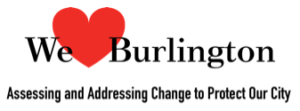 We are the WeLoveBurlington Advocacy Group. We are distinctly ‘grass roots’ and non-partisan. We advocate on a broad range of issues that affect the City of Burlington and its citizens. We are the WeLoveBurlington Advocacy Group. We are distinctly ‘grass roots’ and non-partisan. We advocate on a broad range of issues that affect the City of Burlington and its citizens.
At the outset, we would like to note several directions and tendencies of the current provincial government that have given us cause for ongoing concern and which we see unfortunately reflected in Bill 108.
First, a general rush to precipitous action with insufficient consultation with affected parties, interest groups and citizens generally. We understand that Bill 108 and its consequences are entirely within the powers and prerogatives of the provincial government. However, we firmly believe that appropriate and timely consultation with the electorate is a fundamental principle of the democratic process. Such has not occurred here.
Second, a tendency to download program funding and operational responsibilities with little consideration of their ultimate financial or operational impacts. Indeed, in many cases these potential effects are both unidentified and unclear resulting in a needlessly dynamic policy context and unfunded budgetary pressures. The result will predictably be reduced services, higher tax burdens and larger municipal debt.
Third, a tendency to disrupt and overload the existing framework of municipal services by imposing a quantum of change that is beyond the limited capacity of the municipality to accommodate. Bill 108 is simply the latest example of a series of provincially imposed changes to local municipal program delivery that were unplanned, unanticipated and threaten to render dysfunctional an already over-extended system.
In reviewing the proposed Bill we have multiple concerns but have limited our comments, given the very brief amount of time allowed for response and comment, to those that follow.
Threats to Bio-Diversity
The consequences of global heating and the need for preservation of bio-diversity are of the utmost importance to our province and our country in the 21st century. Unfortunately, instead of increasing the strength of our protections for these crucial needs, Schedule 5 of Bill 108 makes it easier for plants and wildlife habitat to be destroyed. If enacted as proposed, Bill 108 would lead to significant delays and uncertainty regarding listing of species at risk, provide for more exceptions and mechanisms for escaping the prohibitions, severely limit the government’s actions to protect and recover species at risk, and remove requirements for the Minister to consult with species experts. The amendments would also allow proponents to harm some species at risk in exchange for benefiting others (through landscape agreements) and create a mechanism where proponents can pay a regulatory charge in lieu of meeting conditions on a permit designed to protect and recover species or its habitat. The new term “pay to slay” that is finding traction with constituents is an apt if somewhat grotesque label.
Schedule 5 will accelerate the decline of species. This is not a trade-off voting constituents are willing to support.
Schedule 5 should be eliminated from this Bill in its entirety.
Shorter Timelines for Review of Applications
Setting shorter timelines for the review of development applications directly impacts the ability of municipal planning staff to deal with the comprehensive nature of applications, consult with the public, or seek collaboration with applicants. Instead of allowing for the community and parties to work together, shortened timelines will increase adversity. There are impractical timelines for staff and Council for even the most simple, straightforward applications. The result will be even more appeals for non-decisions, thereby defeating the desire to increase housing faster.
Return to de novo Hearings
While the LPAT remains, it will no longer evaluate appeals based on compliance with official plans and consistency with provincial plans/policies. Bill 108 returns it to the more adversarial OMB process and, as such, a return to de novo hearings. This is very disappointing for residents and municipal governments, as it takes final planning decisions out of elected councils’ hands. Historically, the use of a de novo approach to appeals has resulted in drawn out hearings, lags in decisions and a backlog of cases. The return to this process has no positive effect to speed up housing development. This aspect of Bill 108 has been characterized as a return to the substance (if not the fact) of the former Ontario Municipal Review Board. We agree and consider it a fundamental flaw of the proposed legislation.
Parkland and Development Charges
A long-standing tenet of land use in Ontario, as established by the province and undertaken by municipalities, is for the building of complete communities – places where homes, jobs, schools, community services, parks and recreation facilities are easily accessible. As intensification and vertical housing become more prevalent, particularly in cities such as Burlington that are targeted for intensification, access becomes even more important.
For decades, the province has allowed municipalities to require parkland based on number of units being built, creating a direct relationship to the number of people living in a new development. If cities choose to keep a limited version of the parkland dedication by-law, they lose the ability to collect land or cash based on units built and are limited to require 5% of the land area of the new development. A 5% requirement on a small site being used for a high-rise development does not deliver a “park” space for residents that will contribute to livability in any manner.
Our parks are critical pieces of infrastructure that not only help to alleviate the effects of global heating but also play a pivotal role in creating places where people actually want to live. Further, Bill 108 compels cities to spend 60% of the money they collect each year, thus making it harder for cities to save up funds for larger park projects and land purchases.
Not only does Bill 108 severely curtail the ability for cities to require developers to provide parkland onsite, it also removes the ability for those same cities to use development charges to collect money for parks and other soft infrastructure. The proposed new development charges amalgamate many of the tools cities have used for things such as affordable housing and turned them into either/or situations. These restrictions are exacerbated by a yet-to-be identified cap the government will announce at a later date.
No Answers to Affordable Housing
Bill 108 does not provide for any mechanisms to ensure that reduced development costs are passed through to future home buyers and renters.
In large part the development industry is permitted to build the product it most wants, wherever it desires and sell it at whatever price it chooses.
Allowing municipalities to utilize inclusionary zoning as one of a suite of tools to address and increase the supply and integration of affordable housing through private development represents a more effective manner with which to create affordable housing. By doing so, municipalities maintain the flexibility to utilize the tools most appropriate to the local context.
In Summary
Bill 108 does not represent the government action voting constituents want from provincial leaders. The City of Burlington and municipalities like it across Ontario have well planned strategies for growth with specific areas identified for intensification and new development.
Reasonable timelines are in place to ensure professional review and assessment of development applications while providing constituents with a voice. The City of Burlington currently has in place an Interim Control Bylaw that has imposed a hiatus on development applications for one (potentially two) years. The bylaw was enacted as a necessary mechanism to cope with both the volume and the complexity of current development applications. This would override it and introduce virtual chaos into the evaluation and approval process.
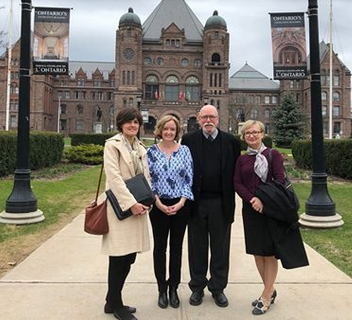 Lynn Crosby, Deborah Ruse, Blair Smith, Josie Wagstaffe We strongly urge you to pause Bill 108 in its entirety and work in tandem with the City of Burlington, the Halton Area Planning Partnership and like bodies across Ontario to attain plans and policies that reflect clarity, consideration and certainty in managing growth, delivering suitable development for our population and building infrastructure that works in favour of the people and the environment.
If the current government is truly “a government of the people” receiving its direction from ‘the people’, then it needs to both listen to their voice and permit them the time to articulate it.
Sincerely, Lynn Crosby, David Myers, Deborah Ruse, 0Blair Smith, Josie Wagstaffe

 By Staff By Staff
July 29th, 2019
BURLINGTON, ON
Oakville Burlington North MP Pam Damoff asks: “Are you or someone you know a small business owner looking to making your business more energy efficient? If so, I am writing with good news.
“Last week, the Minister of Environment and Climate Change, Catherine McKenna, announced that small- and medium-sized businesses in Ontario can now apply to the SME Project stream of the Climate Action Incentive Fund.
 “Small and medium-sized businesses in our province will be eligible to receive funding of up to 25 percent of the cost of projects that will make their businesses more productive and competitive as they reduce energy use, save money, and cut greenhouse gas pollution. $72.4 million has been earmarked for Ontario for 2019-20 through the Climate Action Incentive Fund. “Small and medium-sized businesses in our province will be eligible to receive funding of up to 25 percent of the cost of projects that will make their businesses more productive and competitive as they reduce energy use, save money, and cut greenhouse gas pollution. $72.4 million has been earmarked for Ontario for 2019-20 through the Climate Action Incentive Fund.
“A wide range of projects are eligible, including building retrofits, improved industrial processes, fuel switching, and the production of renewable energy for the use of applicants. Proposals will be selected on a first-come, first-served basis, and regional considerations and prioritization for the most impacted small- and medium-sized businesses will be taken into account.
Applicants can consult the applicant guide to prepare their proposal and submit it through the online application tool. Applicants will be notified of the decision after approximately 25 business days upon receipt of their application.
“Over the next five years, small and medium-sized businesses in Ontario, New Brunswick, Manitoba and Saskatchewan will have access to $1.45 billion to support actions such as increasing the energy efficiency of their operations.
“Applications were opened on July 17th, 2019 and will remain open for 90 days from it’s launch or until funding is exhausted. All small- and medium-sized businesses who employ less than 500 people are eligible to receive funding through this program.
 Oakville Burlington North MP Pam Damoff “In addition to this funding announcement, the Government will soon launch a new call for proposals for smaller projects from small businesses across the country, under the Low Carbon Economy Fund Partnerships stream. Approximately $10 million will be available to help those businesses make investments to improve energy efficiency, reduce pollution, and save money. I will be sure to update you again when this new stream comes online.”
This is a federal program. Damoff was the first to get something out – if you live in a different riding – find the MP there – they won’t be hard to find – they are all now in election mode – and get some help from their office staff.
Do keep in mind that every MP now has two offices. Their constituency office and their campaign office..
Burlington is MP Karin Gould, also a Cabinet Minister and Lisa Raitt, the MP for Milton, which includes some of the northern part of the city of Burlington.

 By Pepper Parr By Pepper Parr
July 28th, 2019
BURLINGTON, ON
This is a seven part series on transit and how Burlington plans to get to the point where the public will take public transit to get to where they want to go in the city because it is cheaper, faster, more convenient and seen as the smart thing to do.
Part 4.
Customer Experience
Burlington Transit already offers real-time trip information and an acceptable level of comfort, accessibility and shelter. However, more in-depth real-time operational information and proactive communication would give passengers certainty and a sense of reliability. Improved accessibility and increasing the provision of shelters help to remove barriers to transit use, making it an option for more members of the community. Finally, enhanced digital connectivity builds on one of transit’s competitive advantages – the ability to dedicate attention to digital devices to get work done and stay connected while travelling.
Customer experience enhancements can encourage new customers to transit and, importantly, keep existing customers on the system.
Strategy 3A: Improve Communications
Beyond real-time trip information, communications regarding planned and unplanned disruptions is the next most important information that passengers need to improve their comfort in using the service.
Burlington Transit currently publishes their planned disruptions on their website, but there is little integration of this information with trip planning services. An analysis of Burlington Transit’s staffing levels and discussions with key staff members have indicated that there are less on-road operations supervisors than necessary to provide full coverage of all services.
While operational recovery from disruptions is paramount, affected passengers need to be made aware of the problem, its outlook and their alternatives as soon as possible. To ensure that customers are aware of the actual operating environment on the routes and services they need to take, a service standard should be set to publish unplanned disruptions on the Burlington Transit website and provide the information to the open data (Google Transit) API within 15 minutes of them occurring. This will require additional operations staff to address disruptions and better communication with Customer Service.
These initiatives align with Burlington Transit’s Strategic Direction #2 (Be Forward-Thinking in how services are planned and delivered), particularly Objective 2.1 (Technology) as they work to harness existing and new technologies to deliver a better customer experience.
Recommendations:
• Establish a new service standard to ensure that all disruptions and unplanned events are
published on Burlington Transit’s website, to the open data (Google Transit) disruptions API and social feeds within 15 minutes of them occurring.
• Hire operations administrative dispatch clerks to support on-road operations supervisors and enhance communications with Customer Service.
• Investigate partnerships with third-party trip planning apps to provide riding assistance to new customers.
Strategy 3B: Improve Comfort and Accessibility at the Stop
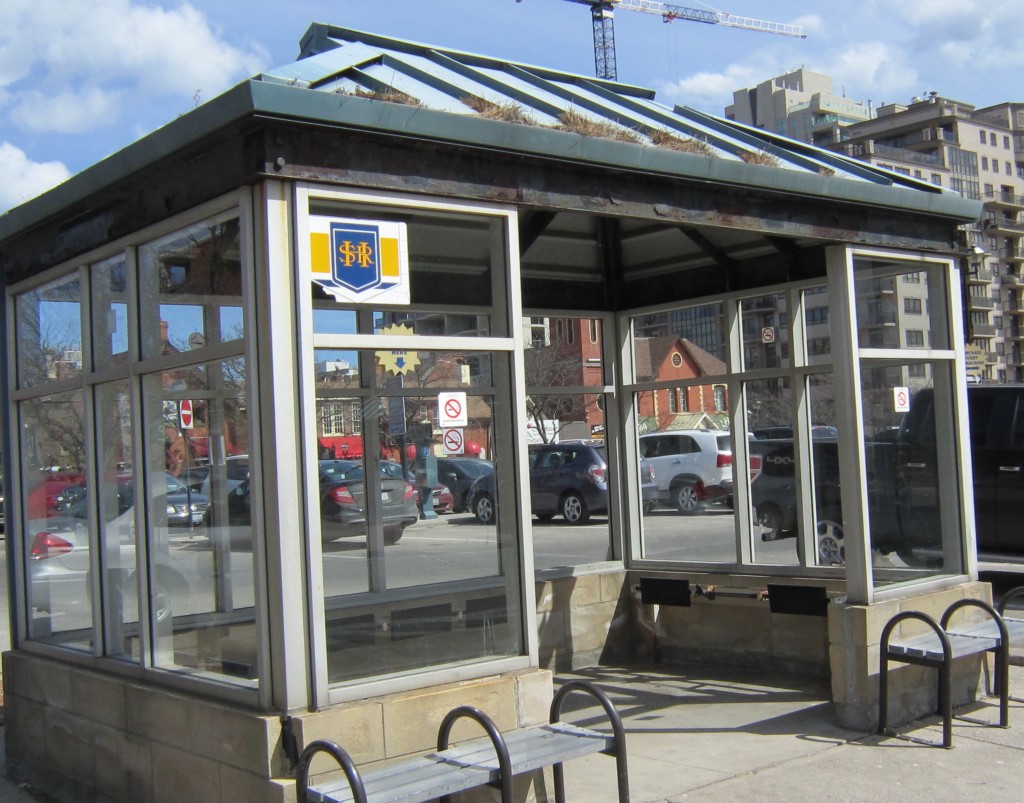 Many of the shelters were in very poor condition – that has begun to change. Piping in music would be nice. To continue to progress towards a more accessible system, Burlington Transit is finalizing a 2019 Accessibility Plan, which forms part of the City of Burlington’s Multi-Year Accessibility Plan 2019-2024. The Accessibility Plan outlines actions to remove barriers and improve accessibility. Many items in this business plan echo initiatives in the accessibility plan, including improved frequency, improved communications and improved links with neighbouring municipalities. The plan also includes a bus stop upgrade program and the additional of real-time information screens at the Burlington GO Station and the Downtown Terminal. In addition, Burlington Transit has recently formalized new bus stop design standards (see Strategy 3C), which define dimensions, access, orientation and other requirements for accessible transit stops and shelters.
Recommendations:
• Continue to implement key actions in the 2019-2020 Accessibility Plan.
• Develop updates to the Accessibility Plan for each year subsequent year during the business plan period.
• Expand the bus stop upgrade program to include accessible shelters (see Strategy 3C).
Strategy 3C: Shelters
A customer’s perception of the transit experience starts before they board a vehicle. One of the first interactions with the system on the day of travel is waiting for the service at a stop. Shelters provide customers with a place to take refuge during inclement weather (rain, snow and strong winds) or shade during hot summer days. They also provide a source of information about the service and a sense of permanency of a transit system, particularly on routes that provide direct, frequent and rapid service.
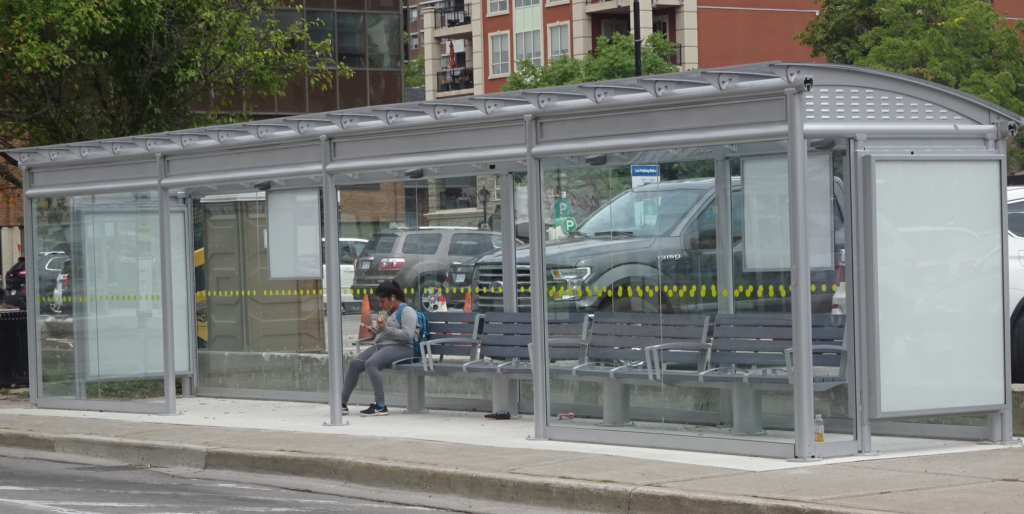 Larger, brighter and cleaner transit shelters. Report suggests Transit work with Parks and Recreation on placement – that would be breaking down a silo. As Burlington Transit continues to expand its service and build on the grid-network, the expansion of shelters should be considered as a key part of improving the customer experience prior to boarding the bus. This could involve a number of key actions:
1. Improve Existing Shelters
2. Develop Shelter Placement Criteria
3. Work with the Burlington Parks and Recreation Department to Increase Natural Shelters at Stops
Shelter improvements work towards Burlington Transit’s Strategic Direction #1 (Be Customer-Focused in every aspect of how service is delivered), particularly Objective 1.6 (Accessibility) as can improve the customer experience and accessibility at the qualifying stops.
Recommendations:
• Continue to conduct bus shelter condition assessments for all existing stops with shelters.
• Create a shelter policy, dictating how stops qualify for shelters and how to prioritize the roll-out of new shelters.
• Work with Burlington Parks and Recreation Department to increase natural shelters at stops.
Strategy 3D: Digital Connectivity
One of the benefits to taking transit is that riders are free to engage in activities that are not possible when driving. Staying connected is increasingly important and it is common to see transit passengers using smartphones and tablets during their journeys. To improve the experience of customers using electronic devices during their travels, Burlington Transit could consider providing charging facilities and wifi. This allows customers to use their time more productively while on longer transit routes, access social media and music streaming services and use their mobile devices to access trip planning tools and be informed in real-time of disruptions in the system.
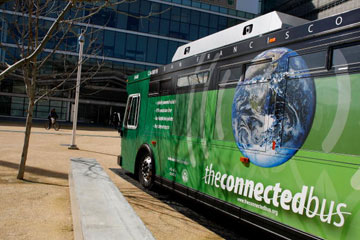 WiFi on buses can be done quite easily. Do it soon. In the shorter term, implementing USB power outlets on buses and wifi at facilities are relatively simple and effective ways to encourage passenger connectivity when using transit. The implementation of these amenities should be on a pilot basis and focused on routes and facilities with higher ridership, to maximize their usefulness and the amount of feedback received.
Connectivity improvements align with Burlington Transit’s Strategic Direction #2 (Be Forward-Thinking in how services are planned and delivered), particularly Objective 2.1 (Technology) as they work to harness existing and new technologies to deliver a better customer experience.
Recommendation:
• Include USB charging points on all new bus deliveries. Charging ports should be located strategically throughout buses, which could be assigned to a single longer-distance route or used throughout the network. Customer feedback and uptake by route and time of day should be collected to optimize the number and location of charging points on future deliveries.
• Implement a wifi pilot at major stations and transfer points (excluding GO Transit stations).
It has been a long long time since the words “customer experience” were uttered in Burlington when talking about transit.
The background report on what could and should be included in the five year plan is sound. Now to get a city council that will take the plunge – do it early in the term and let the public get used to what is coming their way.
Part 1: Transits five year plan has what some might call an over abundance-of wishful thinking
Part 2: Strategies and recommendations to create the needed structure and delivery model.
Part 3: Making all the parts fit.

 By Pepper Parr By Pepper Parr
July 28th, 2019
BURLINGTON, ON
One of the really big issues during the October election was that city council was not listening and that city staff weren’t much better at listening either.
There were enough of the 40% of the population that took the time to vote who saw it that way and put in a very different council.
What has taken place within the halls of city council since the new council took over? Any positive changes? Actually yes.
The group re-examining the downtown policies in Burlington’s adopted Official Plan reached out to a number of groups asking them to take part in the creation of an engagement and communications plan that included key groups of citizens and community organizations.
In their reaching out they said: “Over the next few months, the City of Burlington is re-examining the downtown policies in the City’s adopted Official Plan. City staff have direction from Council to engage the community in this work.
“To make the engagement plan the best possible, we need your help to create an engagement and communication plan that will encourage a broad section of the community to participate and have their say. In re-examining the adopted Official Plan, the City wants to hear from all interested in the project and/or affected by the outcome, including those that were not represented in the previous engagement on the adopted Official Plan.”
In their first meeting with groups they set out the direction they wanted to go. “For today’s discussion, there are a few things that are helpful to remember. Council has directed staff to complete the re-examination, including the following project milestones:
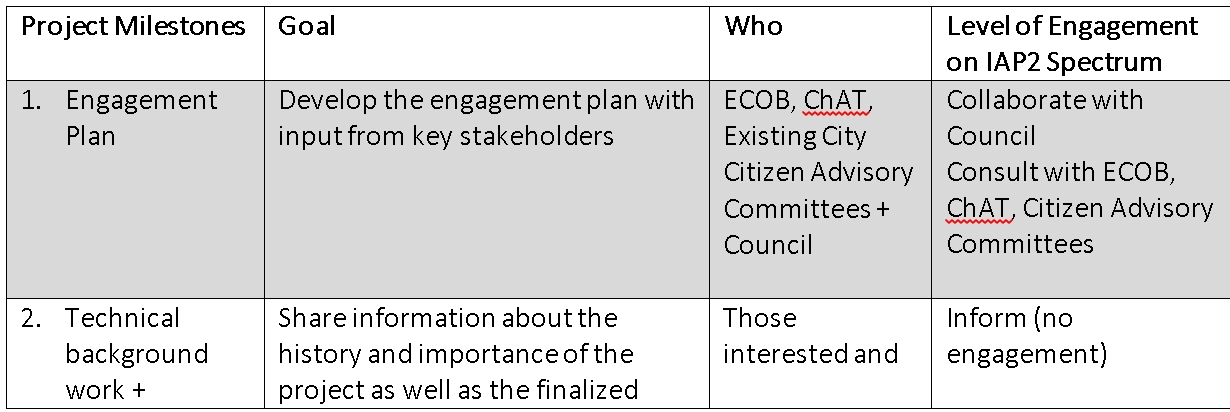  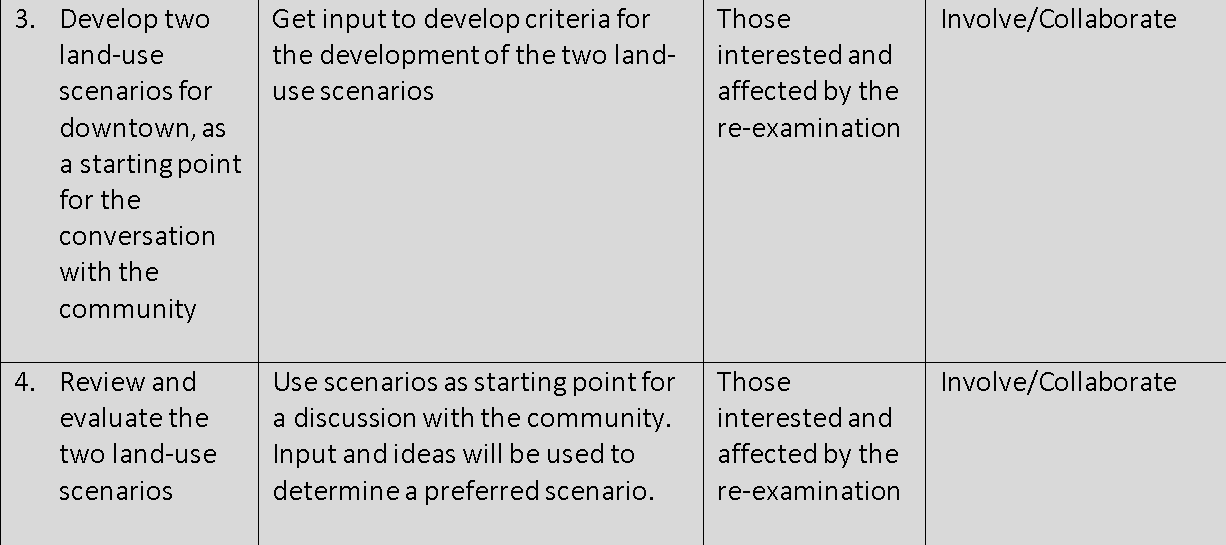 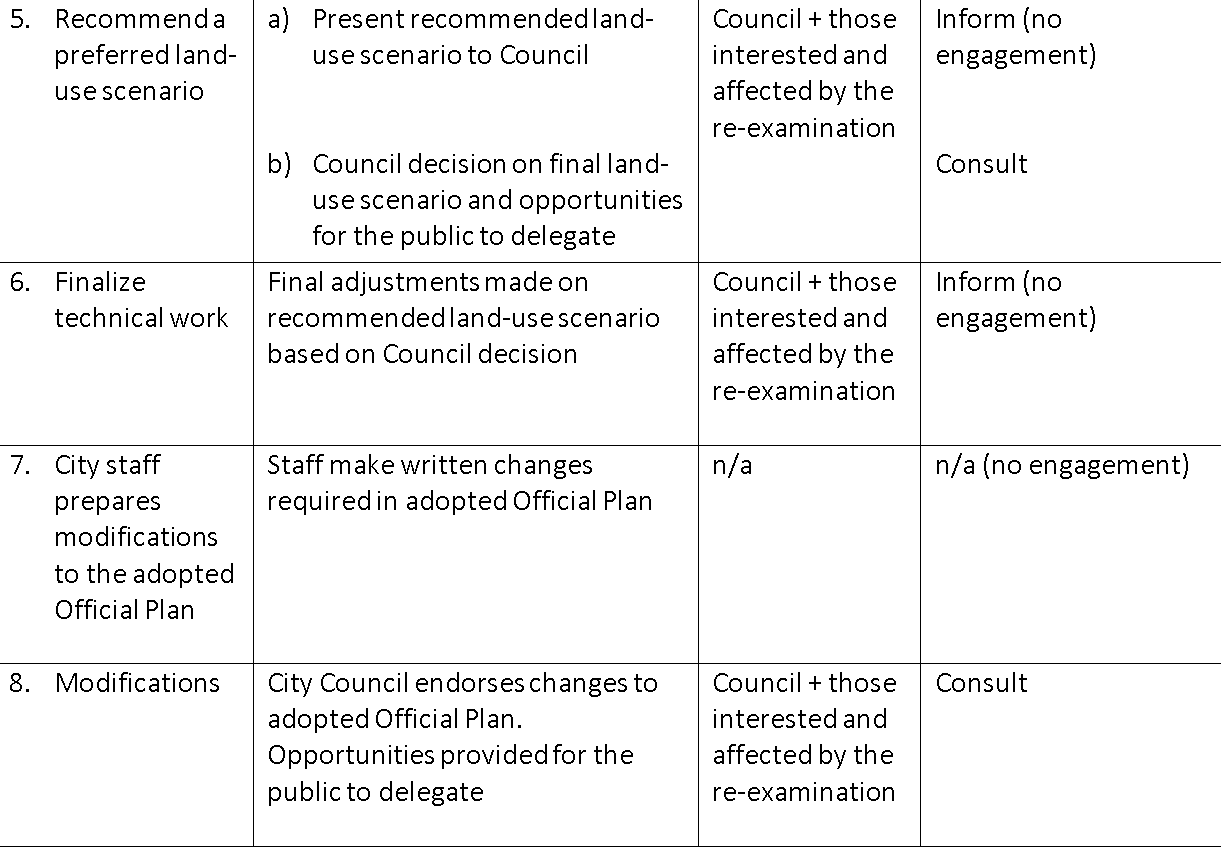 
The staff people leading the sessions began by seeking “input on the development of the engagement and communication plan.” Statements like that were not heard all that often. Thee Gazette is aware of at least one meeting with members of the community and a group of planners where a senior staff member shouted at one of the participants.
In the outline material people were given at this session the staff facilitators said: “Now that you know what is up for discussion, we also want you to know what is not up for discussion. We think these points are important in order to be up front about which aspects of this process cannot be influenced.
1. The re-examination is focused on the downtown only, not the whole city
2. Planning policy is guided by legislative requirements, such as Provincial Policy Statement, provincial plans including Urban Growth Centre policies, Halton Region Official Plan, Bill 108, Big Move/Metrolinx
3. The scope of work, timing and resources including the terms of reference, has been approved by Council through a staff report that includes the development of two land use scenarios as a starting point for the conversation with the community
4. Previous development approvals will not be revoked
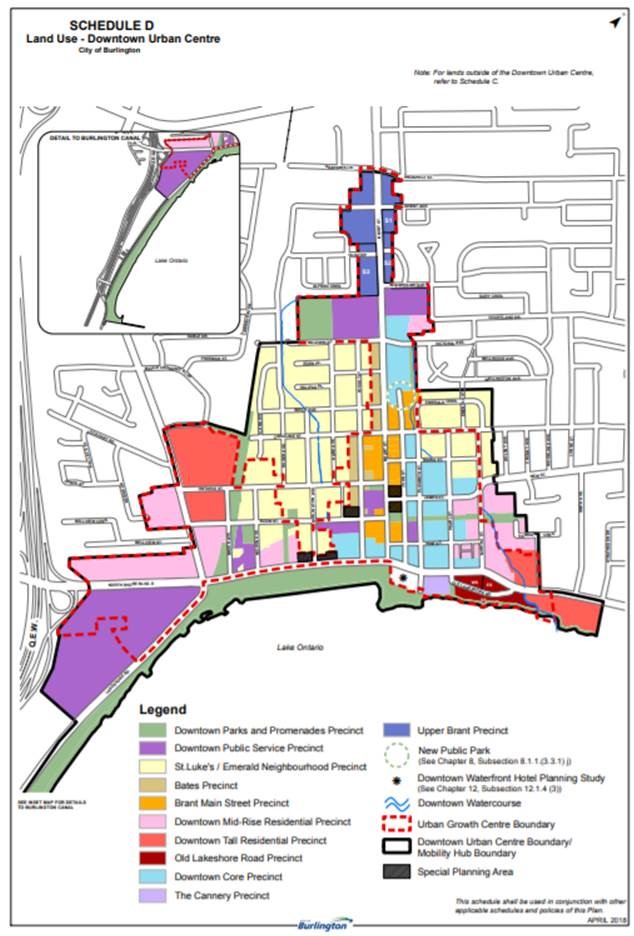 Coming up with a plan that creates a way to communicate with the public that wanted change in the way thee downtown core is grown in the future. 5. The proposed downtown plan and policies must be developed with the objective of being able to withstand possible appeals to the LPAT
6. The basis of the re-examination is the adopted Official Plan, not the current, in-effect Official Plan
7. The Interim Control ByLaw (ICBL) Land Use Study is a separate study
8. Halton Region is the authority that approves the City’s Official Plan and decides whether to approve any modifications endorsed by the City
9. Modifications must be endorsed by City Council by March 2020
10. The City doesn’t have control over the speed of change related to development, e.g. developers are guided by market forces.
The Scope of Engagement was explained:
“Through discussions at Council meetings, Council has identified a list of topics that need to be included in the engagement with the community. These topics are listed below.
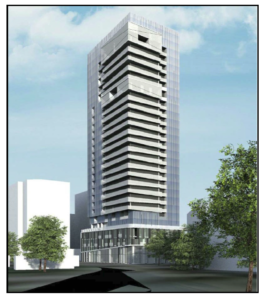 This is what citizens didn’t want. • The height of buildings
• Density of development
• Location of intensification
• Degree of change
• Options and trade-offs
• The development of policies that ensure development respects and maintains downtown Burlington’s identity/sense of place, and its role as a shared core area for all residents of the City
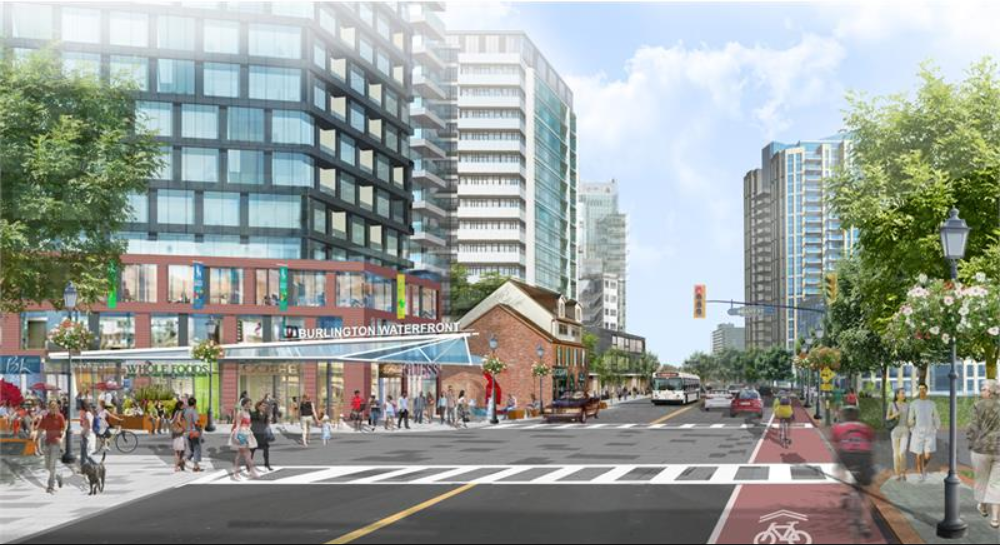 Is this what the downtown core is going to look like – how will it relate to the rest of the city? • How the downtown connects/relates to the rest of the City
• The use of mechanisms to achieve desired amenities and infrastructure (including office space, retail space, affordable housing, seniors’ housing, parks, open space, street trees, public spaces)
• The approach to policy development, e.g. the use of strictly defined development maximums or flexible development ranges
• Compatibility with established neighbourhoods that surround the downtown
• The development of policies to protect the waterfront, small retail spaces, and cultural heritage resources.
Participants were asked to share their thoughts on the list. They were asked if anything was missing?
The facilitator added: “Looking at the direction from Council, we want to talk to you about techniques, tools and communication approaches that will help ensure broad participation in the re-examination.
One of the exercises was for the participants to develop two land-use scenarios for downtown. They would gather input to develop criteria for the two land-use scenarios which will be used as a starting point for the conversation.
The sessions are taking place from Mid-July – mid-August 2019.
The participants were given a list of engagement techniques
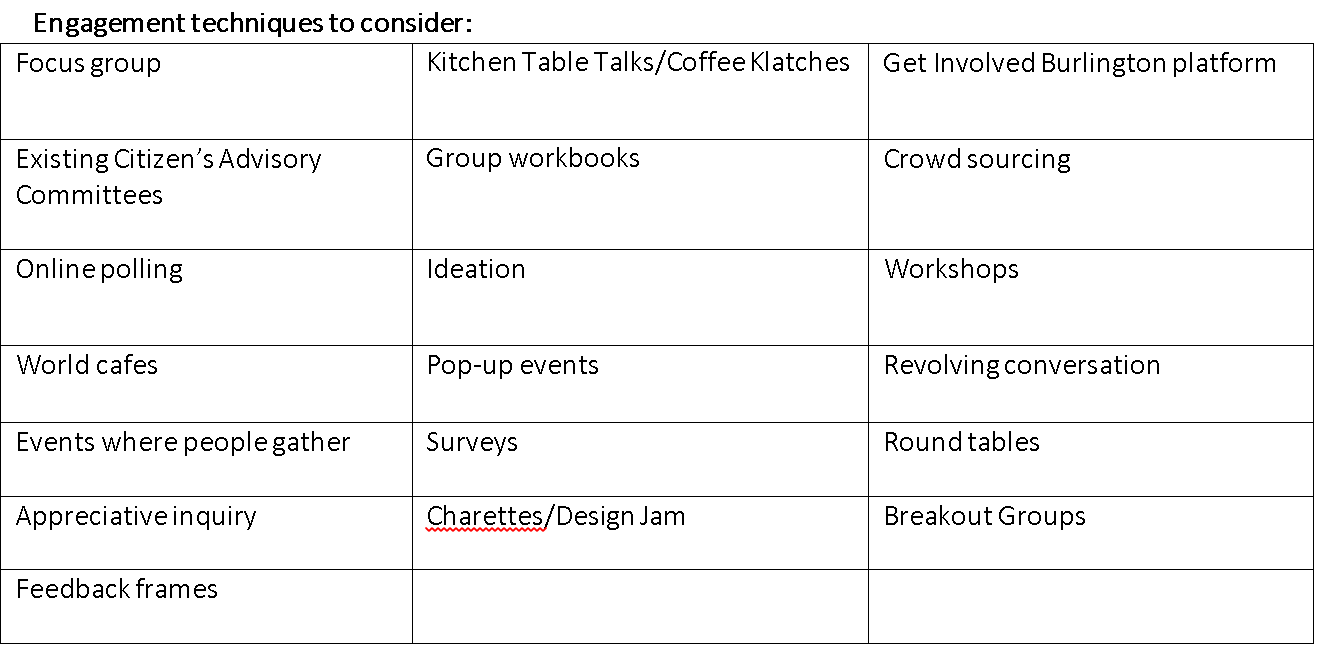
to consider and asked:
 The city used to hold public meetings on budget proposals – they were for the most part city staff telling the public what was going to be done with little in the way of feedback that got much further than the room they were uttered in. The initiative taking place now appears to be an attempt to change the way the city engages its public. • Which of these techniques do you feel would be most successful in gathering representative input from the community?
• Can you think of any others?
• Which of these techniques do you feel would be most successful in gathering representative input from the community?
• Can you think of any others?
“Thinking of the ideas you’ve provided; can you give us some guidance on time of day and days of the week that you think would be the most successful for gathering representative input from the community?
“To provide as many people as possible the opportunity to participate in the re-examination of the downtown policies, can you share ideas for communication approaches and outreach techniques that would be successful in reaching a broad section of the community? Have you seen other approaches that worked well?
“What would a successful engagement look like to you?
“In your opinion, is there any communication approach that should be avoided?
The ideas and feedback that come out of the sessions will be used by City staff to create an engagement and communication plan for the re-examination of the adopted Official Plan.
The approach that has been set out is as good as it gets. All the bases are covered and staff seem to be fully committed to the objective. This is not one of those ‘check off the boxes’ exercise.
During the hectic period during which debates were taking place in all six wards courtesy of ECoB – two Councillors could find nothing decent to say about the organization. Kudos to staff for inviting ECob into the conversations. They earned the right to be there.
Someone at city hall deserves a lot of credit for taking the direction the facilitators are on; it augers well for the kind of thinking that we should see in September.

 By Ray Rivers By Ray Rivers
July 26th, 2019
BURLINGTON, ON
“Chocolate milk saved my son’s life” – Andrew Scheer
No that wasn’t the latest idiotic outburst from America’s Donald Trump. This is a serious comment from the political leader currently ahead in the polls going into Canada’s next election. Andrew Scheer is shunning the evidence provided by Canada’s leading health scientists and dieticians and shamelessly catering to the dairy and meat producing industry.
 “Chocolate milk saved my son’s life” – Andrew Scheer Deja vu? You bet! This behaviour should hardly be surprising, coming from someone who was a member of Stephan Harper’s ideologically-driven government. Science and knowledge were considered a potential threat to their lifestyle, or at least their ideology. So show me no evil… Didn’t Harper eliminate the long form census and muzzle government climate scientists?
The Canada Food Guide, which first appeared in 1977, is an integral component of Canada’s universal health care system. As we know, diet and exercise play a huge role in determining the state of our health. And in a publicly funded health care system with limited resources, it just makes sense, economically and holistically, to eat well in order to avoid problems that may land you in the doctor’s office or the hospital.
Former versions of the guide had been criticized by some health professionals as just another piece of advertising for the animal food industries, and thus misleading, inaccurate and past its best before date. A decade later and with a different government at the helm, the new guide has attempted to finally address that criticism.
 Obesity, especially in children, is a major public health issue. Meat and diary are still there but meat is now, along with nuts and legumes, just a source of protein. And water is favoured over milk as the drink of choice. As we know, not everyone can tolerate lactose and not all adults can metabolize milk, which questions its value as the best dietary source of calcium. And haven’t a number of dairy products, including the chocolate milk Scheer feeds his children, been linked to the rising levels of obesity and diabetes in our society?
It is understandable that representing a riding in Saskatchewan, a province where agriculture along with oil and potash make up the economy of the province, that Andrew Scheer would feel compelled to defend farm interests. But not all farmers are dependent on animal husbandry and there are always other agricultural production options for those who currently are.
Scheer has been taken to task for claiming that ideology and not science was behind developing the new food guide. Having only ever been a politician, except for a brief stint selling life insurance, how would he possibly know that? And in fact he doesn’t – he has it wrong. It is he who is the ideologue.
 The new Canada Food Guide is a science-based document which has been extensively researched and was crafted following wide ranging consultations across our society. It has taken a decade for the officials responsible to muster the courage to come forward, break with tradition, and tell it like it is. The guide is signalling that it’s time to cut back on meat and milk and salt and sugar… and fast food. The new Canada Food Guide is a science-based document which has been extensively researched and was crafted following wide ranging consultations across our society. It has taken a decade for the officials responsible to muster the courage to come forward, break with tradition, and tell it like it is. The guide is signalling that it’s time to cut back on meat and milk and salt and sugar… and fast food.
Something is unhealthy in the state of Canada… and it’s our eating habits. If our reliance on fast food and excessive meat and dairy is normal, then our rates of obesity, diabetes, heart disease and cancer must be too. If we want to change the outcomes we need to change the inputs, what and how we eat.
To that end the guide promotes cooking at home rather than the ever growing practices of eating out and ordering in. Nothing could be more traditional than that, especially for a staunch ideological conservative like Mr. Scheer.
 Ray Rivers writes regularly on both federal and provincial politics, applying his more than 25 years as a federal bureaucrat to his thinking. Rivers was once a candidate for provincial office in Burlington. He was the founder of the Burlington citizen committee on sustainability at a time when climate warming was a hotly debated subject. Ray has a post graduate degree in economics that he earned at the University of Ottawa. Tweet @rayzrivers Ray Rivers writes regularly on both federal and provincial politics, applying his more than 25 years as a federal bureaucrat to his thinking. Rivers was once a candidate for provincial office in Burlington. He was the founder of the Burlington citizen committee on sustainability at a time when climate warming was a hotly debated subject. Ray has a post graduate degree in economics that he earned at the University of Ottawa. Tweet @rayzrivers
Background links:
Fact Checking Scheer – Misinformation – Canada’s Food Guide –
Food Guide Explained – Industry Concerns – Scheer and Bias –
Milk and Calcium –

 By Pepper Parr By Pepper Parr
July 26th, 2019
BURLINGTON, ON
This is a seven part series on transit and how Burlington plans to get to the point where the public will take public transit to get to where they want to go in the city because it is cheaper, faster, more convenient and seen as the smart thing to do.
Part 3
Mobility Management acknowledges all the ways that people can travel in a community and all of the different ways that these modes can be operated; bringing them together for the benefit of the customer. While Burlington Transit primary focus over the next years will be the delivery of public transit services, it is important to start investing and rethinking how Burlington Transit thinks about mobility as a whole.
Strategy 2A: Implement On-demand Alternative Service Delivery Models
On-demand transit (or microtransit) is a traditional form of mobility that is experiencing a resurgence with the help of technology. On-demand transit has four components that differentiate it from conventional fixed-route transit:
• Flexible routing and/or scheduling designed based on customer demand;
• Newly-emerged “mobility brokers” who use mobile apps to connect supply and demand;
• Use of smaller, more flexible vehicles; and
• Connecting multiple transportation services to complete a trip (using a mobile app).
On-demand transit can be differentiated from conventional transit in the way that it caters to individual needs. In an On-demand Transit model, the transit service adapts to its customers, while in conventional transit service models, transit customers must adapt to the service offered. In many cases, this provides greater convenience and customization – moving towards some of the favourable characteristics of private automobile travel. On-demand transit offers a level of flexibility, convenience, and individualism somewhere between regular fixed-route transit (“public collective transport”) and private individual transport.
There are several advantages to exploring the implementation of On-demand transit services:
• Cost Effective: On-demand transit services are typically planned in areas where there is low ridership in a larger geographic area. This allows the transit agency to reduce the number of resources required to provide service.
• Improved Coverage: On-demand transit services offer a significant advantage in terms of coverage area. Since the vehicle is not tied to a fixed-route, this increases the number of residents within a five-minute walk of an on-demand transit pick-up or drop-off point.
• Early Introduction of Service: On-demand transit service allows for early introduction of transit service in newly developing areas without committing significant resources to provide mobility for new residents.
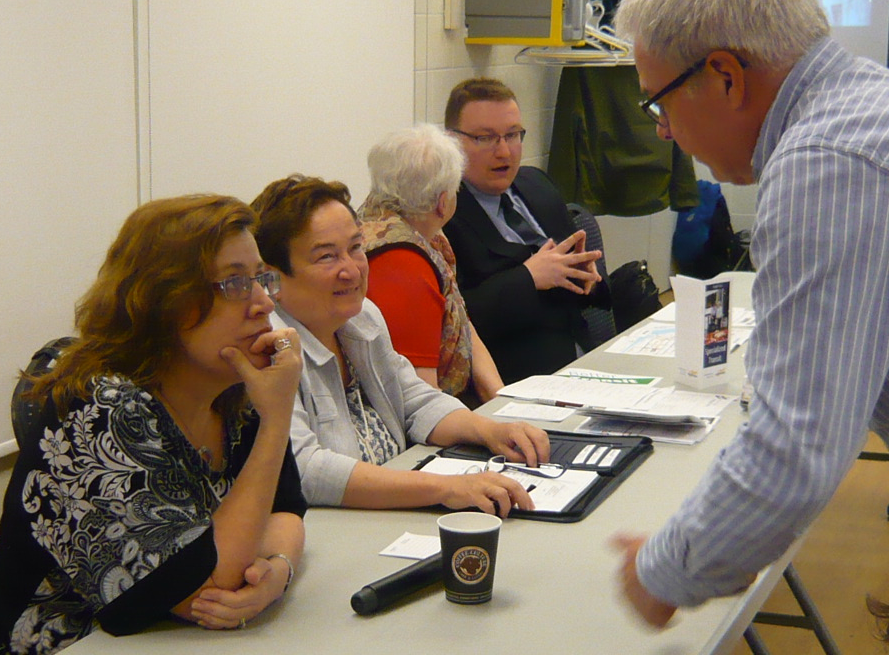 Director of Transit Sue Connor gets out into the community and listens: seen as effective by those who have worked with her and close to adored by her staff who are energized and motivated. On-demand transit services do not entirely replace the need for fixed-route services. Fixed-route transit services require customers to make travel decisions based on pre-set transit routes and schedules. This model is effective when:
• Residents are in close proximity to a service;
• The route provides relatively direct service with minimal deviations that increase travel times;
• Higher frequencies are provided to increase the flexibility of the service; and
• There is a high demand for service between similar origins and destinations, which requires a high capacity vehicle to service.
This initiative works towards Burlington Transit’s Strategic Direction #2 (Be Forward-Thinking in how services are planned and delivered), particularly Objective 2.2 (Alternative Service Delivery), by exploring and seeking to implement on-demand alternative services.
Recommendations:
• Further explore the use of On-demand transit services as a replacement of certain fixed-route services. This should include a review of both dedicated and non-dedicated service models.
• Develop an On-demand transit service model and business case for low demand areas and operating periods, allowing customers to use a mobile app to book a shared-ride demand- responsive service to connect to the fixed-route service. This should coincide with the modifications to the existing route network to more of a grid-like structure (see Strategy 2A).
Strategic Direction 2B: Explore Partnerships with Other Mobility Providers
To address this expanding world of mobility, Burlington Transit needs to continue to evolve and see themselves as not only an operator of transit services, but as a partner and collaborator of sustainable mobility services. This means making it easier for customers to take all sustainable mobility options available to them or integrating services to allow customers to easily transfer between multiple modes.
Over the next five years, it is recommended that Burlington Transit continue to explore partnerships with TNCs, bike sharing companies, carpooling companies, taxi operators and other sustainable mobility providers to promote integration with Burlington Transit services. This could include:
1. Information Sharing and Promotion
2. Data Sharing
3. Trip Planning Integration
4. Service Integration
5. Fare Integration
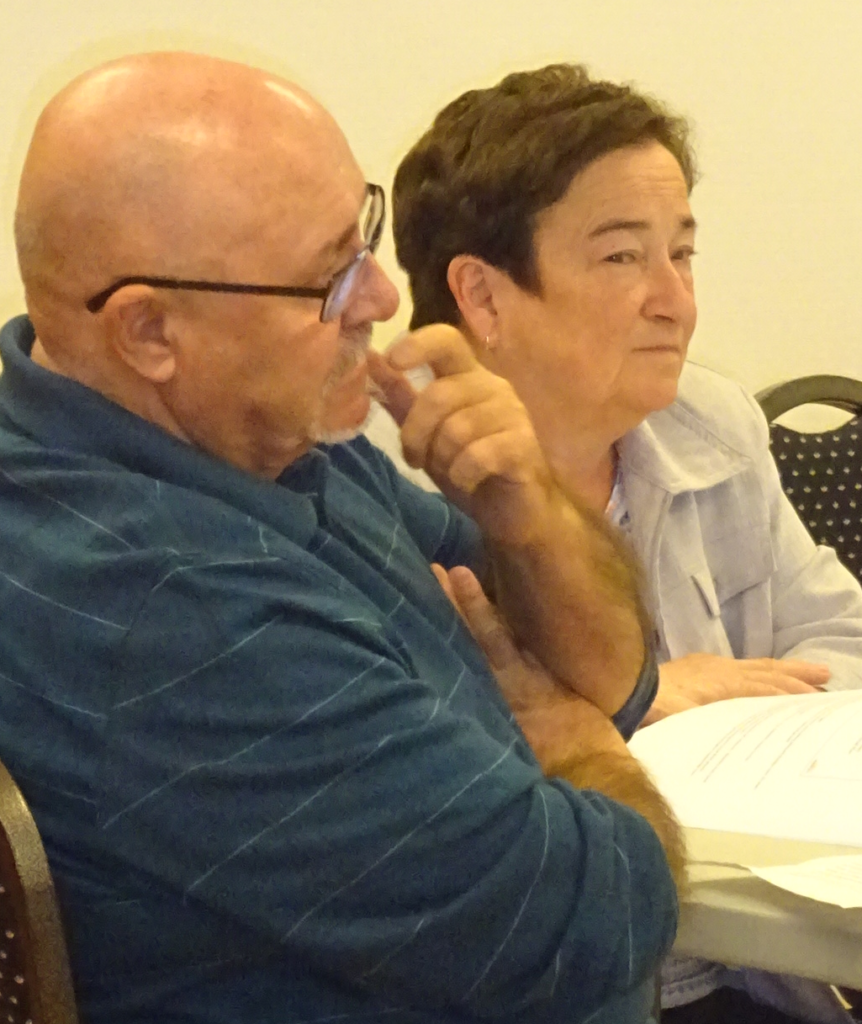 What Sue Connor brought to Burlington was an understanding that transit is both a service and a business – one that goes far beyond running big vehicles up and down the streets of the city. She understands what the future of public transit is likely to be – and gives presentations to anyone who will listen. This strategy aligns with Burlington Transit’s Strategic Direction #3 (Be Business-Minded and aligned with municipal directions), particularly Objective 3.2 (Partnerships), by seeking to partner with providers to improve efficiency, systems and lower cost.
Recommendations:
• Expand the role of a senior member of the Burlington Transit administration and management team to include the exploration of partnership approaches with other sustainable mobility service providers.
• Promote sustainable mobility services through awareness, marketing and education campaigns to inform residents of alternatives to driving alone in private vehicles.
Strategic Direction 2C: Integration of Specialized Transit and On-demand Transit Service
A key strategic direction will be to better integrate specialized transit trips with On-demand transit trips. If Burlington Transit uses its own fleet to deliver On-demand transit services, it is recommended that the Specialized Transit logo be removed from all its specialized transit vehicles, replaced with a Burlington Transit logo.
This will allow the same vehicle to be used to provide both specialized transit and On- demand Transit Services. The goal is to provide more flexibility in utilizing the right vehicle for the right type of trip, irrespective of whether a customer is registered for specialized transit service. This strategy helps support the integration of customers on vehicles that were traditionally reserved for specialized transit customers and will allow for more efficient scheduling and increase the available capacity to all Burlington Transit customers.
Under the integrated service model, a vehicle used to provide specialized transit service can also be used to provide On-demand transit service, and vice versa. This means that the services would be “co-mingled”, and specialized transit and On-demand transit service customers may share vehicles if it provides greater efficiency in the delivery of their trips. The decision to integrate trips will be based on the ability to utilize existing in-vehicle capacity and provide a better level of service to customers.
It should be noted that specialized transit will continue to operate as a core service for registered customers and any integration with On-demand transit service should not reduce the level of service for registered specialized transit customers.
Integration helps to achieve Burlington Transit’s Strategic Direction #3 (Be Business-Minded and aligned with municipal directions), particularly Objective 3.3 (Efficiency), as it allows for the delivery of similar on-demand services to combined, thereby reducing unnecessary administrative and operational duplication.
Recommendations:
• Explore the concept of integrating specialized transit services with On-demand transit services. A prerequisite of this approach is demand-response software in place to support the functions required by customers and staff.
Part 1: Transits five year plan has what some might call an over abundance-of wishful thinking
Part 2: Strategies and recommendations to create the needed structure and delivery model.

 By Staff By Staff
July 25th, 2019
BURLINGTON, ON
Are you now using those scanning machines in the Supermarket?
And do you have to call the attendant for help?
I avoided the things until I got tired of waiting in the lines at the cash register, which were getting longer – and I always seemed to be behind someone who had a cart loaded with products.
I slowly took to the self-serve scanner – and I am getting to the point where I don’t have to get help all the time.
 If the scanner gets it wrong – you get a bous for catching the error. One of the things that you can’t do with the scanner is point out an error in the price on the product and the price that appears when the scanning is done. What do you do then?
Call the attendant and he or she will make the adjustment – BUT there is more they are supposed to be doing for you.
There is a Scanning Code of Practice that was created in 2002 and is managed by the Retail Council of Canada.
When a mistake is made the retailer is required to give you one item free of charge when the scanned price at the checkout is higher than the price displayed or advertised by the store – and the products price is $10 or less.
If the product is higher than $10 retailers must give you a $10 discount off the correct price.
If you find there is an error bring, it up with the manager – who probably will not know about the policy.
Print out this story – write your shopping list on the back of it and keep it handy. Tell the store manager to give the Retail Council of Canada a call and then to call you and give you what you deserve.
Buyer beware.
The Gazette will be sending a copy of this store to all the major Supermarket managers.
The contact at the Retail Council of Canada is:
Sarah Brown
Social, Media and Email Specialist
sbrown@retailcouncil.org
416-467-3777 or 1-888-373-8245

 By Pepper Parr By Pepper Parr
July 25th, 2019
BURLINGTON, ON
This is a seven part series on transit and how Burlington plans to get to the point where the public will take public transit to get to where they want to go in the city because it is cheaper, faster, more convenient and seen as the smart thing to do.
Part 2:
In setting out the plans for creating a more effective transit plan a number of growth strategies were made the focus for staff over the next five years.
These reflect the Burlington Transit the vision, mission and strategic directions noted in the policy framework and will be supported by an updated organizational structure and an implementation and financial plan. These growth strategies are organized into the following themes:
1. Service Structure and Delivery
The Strategies and recommendations to make this happen are set out below.
2. Mobility Management
3. Customer Experience
4. Travel Demand Management
1. Streamline Service Structure and Delivery
The way services are structured and delivered defines the primary customer aspects of any transit system. Where services go, how often vehicles are scheduled, how long the trip takes, how accessible are stops, and how the service is delivered (focus on customer service) are all key factors in residents choosing not only which services to take, but if transit is an option for them at all.
There are a number of strategic directions that will be implemented over the next five years to move towards this ridership growth target. These are described in more detail below:
Strategy 1A: Move to a More Direct Grid-Based System
Burlington Transit has already recognized the benefits that grid-based systems can bring and is making its first steps towards this goal in its September 2019 service change. In order for the grid network to be successful, there must be continued emphasis on:
• Intensification of land use along the arterial roadway network;
• Connectivity to the arterial grid to expand the market within a five-minute walk of the network;
• Improvements to the pedestrian environment at and connected to bus stops; and
• Investments in service levels to limit waiting times for customers that must now transfer between two arterial routes.
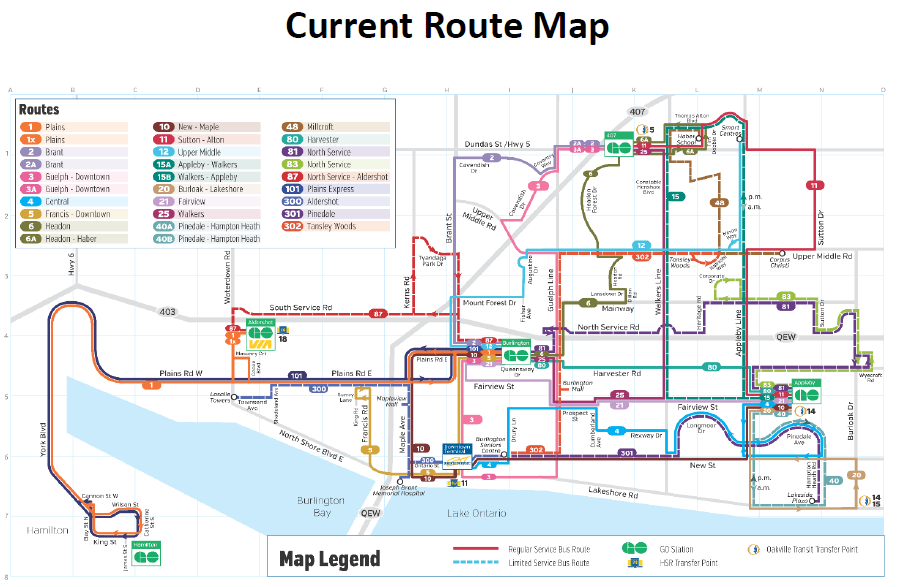 The current route system is not working – it was designed for a different time. 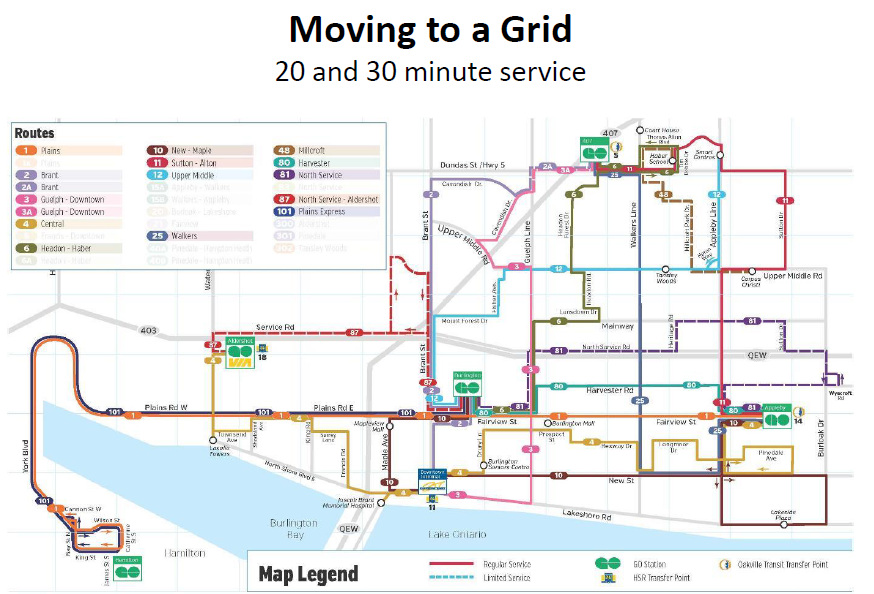 A grid route system will mean a significant realignment of vehicles and something people will have to get used to – but it will solve a lot of the current problems. The Burlington Transit network was developed largely on a grid arterial system, focused on key population and employment areas, with links to the GO Rail network.
Key north-south corridors like Brant and Walkers link the established southern areas to growing northern areas.
Such grid systems allow for more direct routes on arterial roads that are faster, resulting in quicker journeys that attract more riders. While there is a role for local services, the focus of Burlington Transit’s future investment should be on services where they can generate the greatest ridership per invested service hour.
This service realignment works towards Burlington Transit’s Strategic Direction #3 (Be Business-Minded and aligned with municipal directions), particularly Objective 3.1 (Effectiveness), in ensuring that services operated are as effective as possible. Where gaps are left in the network, alternative service delivery options (Strategy 1A) should be explored as a more cost-effective solution to fill them in.
Recommendations:
• Delete circuitous peak-only and after-hours only routes.
• Consider the deletion of circuitous local routes. The removal of these routes should only be considered in concert with the exploration of alternative service delivery options (Strategy 1A).
• Strengthen key arterial corridors and connections to GO Transit stations. Focus on east-west connectivity, with strategic north-south corridors.
Strategy 1B: Increase Service Levels to Support Higher Ridership Growth
Implementing high-frequency service on Burlington’s arterial network may be a challenge given the limited pedestrian connectivity. A number of arterial roads are characterized by rear-lot residential, or long blocks with limited pedestrian connections into interior neighbourhoods.
This makes providing a frequent service on all of the grid-routes a challenge. Since frequency improvements are necessary to facilitate transfers between north-south and east-west routes, Burlington Transit should work with the City’s Planning and Development Department to improve pedestrian connectivity (including road crossings) between arterial transit routes and local neighbourhoods and identify opportunities for mixed-use intensification.
This increase in service levels aligns with Burlington Transit’s Strategic Direction #3 (Be Business-Minded and aligned with municipal directions), particularly Objective 3.1 (Investment), in acknowledging that investment in mobility can improve broader quality of life, achieve economic development and produce environmental benefits.
Recommendations:
• Continue to improve frequencies on Burlington’s arterial grid roads, particularly on the east- west corridors of Plains / Fairview and New, as well as the north-south corridor along Brant.
These corridors are planned to see the most mixed-use, commercial and high density development in Burlington’s Official Plan (2018).
• Work with the City of Burlington Planning and Development Department to increase and enhance pedestrian connectivity between arterial transit routes and local neighbourhoods and identify opportunities for mixed-use intensification along arterial routes.
Strategy 1C: Introduce Transit Priority Features to Improve System Reliability
Transit signal priority works by prioritizing the flow of transit vehicles at controlled intersections. Transponders are fitted to vehicles, which notify traffic light systems of their presence, and request that a green light be extended when transit vehicles are delayed (passive transit signal priority) or that a dedicated signal phase is dedicated to an approaching transit vehicle (active transit signal priority).
Queue jump lanes are transit-only lanes on the approach to, and immediately after, intersections. These lanes allow transit vehicles to ‘jump the queue’ at intersections when they are paired with an active transit signal priority features.
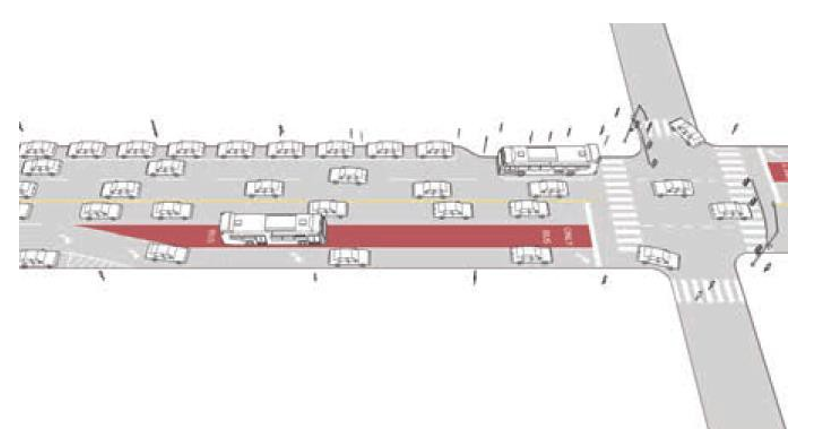 Queue jump lane – it’s a unique idea – and will certainly improve the flow of traffic for buses – drivers in cars will not like it – but we are moving to an occasion when cars ‘share’ the road. Queue jump lanes and signal priority would be appropriate treatments for important transit arterial routes that see less delays and travel time variability, or operate less frequently. Such corridors include Guelph Line north of the QEW or Appleby Line.
Burlington Transit has already undertaken investigations to pilot transit signal priority on the Plains / Fairview corridor. It is intended that this corridor will act as a pilot for the future implementation of such a system across the broader network. This pilot will be implemented in the first year of the business plan and it is expected that an expansion of transit priority measures will occur within the five year life of the plan.
In addition to potential transit priority measures for Burlington Transit services, Metrolinx’s 2041 Regional Transportation Plan includes transit priority along Dundas Street to central Burlington and Frequent Regional Bus services using HOV lanes on Highway 407.
While these measures are focused on regional trips, the Dundas Street priority will also provide direct benefits to Burlington Transit.
This increase in service levels aligns with Burlington Transit’s Strategic Direction #1 (Be Customer- Focused in every aspect of how service is delivered), particularly Objective 1.1 (Service Excellence) and Objective 1.3 (Travel Time) by exploring transit priority measures to achieve faster and more reliable journeys. It also aligns with Burlington Transit’s Strategic Direction #2 (Be Forward-Thinking about how Services are Planned and Delivered), particularly Objective 2.1. (Technology) by exploring new technology to improve reliability and travel time.
Recommendations:
• Implement currently-planned pilot transit priority project on Plains / Fairview corridor.
• Conduct a study of transit priority needs in both the short and long term in Burlington. The study should include a prioritization of potential projects following the pilot.
• Initiate discussions with Metrolinx and advocate for the implementation of transit priority on Dundas Street and Brant Street as part of the overall Dundas BRT project. Ensure that their plans align with Burlington Transit’s needs and complement other transit priority projects.
Strategy 1D: Improve Connections to the GO Transit Network
Services from these stations connect Burlington to Toronto as often as every 5-10 minutes during peak periods and every 30 minutes during non-peak times. Limited peak service is also provided to Hamilton. Almost all of Burlington Transit’s routes currently connect to at least one GO Station, providing a logical transfer point between Burlington Transit routes and links to destinations outside of Burlington. Between 3 – 12 percent of GO Rail passengers in Burlington use Burlington Transit to connect to GO Rail services at each of its stations. This suggests that there is room to grow this market to reach Burlington Transit’s ridership growth targets.
By 2025, Metrolinx plans to improve all-day frequencies on the Lakeshore West Line between Aldershot GO Station and Union Station to every 15 minutes, as part of the “Regional Express Rail” initiative. This will also see travel times between Burlington GO and Union Station reduced by up to 19 minutes, as well as 2 minute savings between Burlington GO and Appleby GO. Regional Express Rail will increase the attractiveness of the service for trips to Union Station as well as other mid-line stations along the Lakeshore West line.
This partnership works towards Burlington Transit’s Strategic Direction #3 (Be Business-Minded and aligned with municipal directions), particularly Objective 3.2 (Partnerships) as it seeks to achieve better and more cost effective options for passengers by working with other transit providers.
Recommendations:
• Improve frequency of direct connections to GO Rail stations with the introduction of RER.
• Explore on-demand alternative service delivery strategies to connect to all GO Train trips that do not conveniently connect to a fixed-route Burlington Transit bus.
• Explore integration opportunities to better utilize the RER network for local express trips within the City. This should include improvements to trip planning tools, marketing and communications and well as service integration.
• Investigate the implementation of a fully-integrated single fare with GO Transit. This would require local trips to be priced on the basis of distance.
Strategy 1E: Increase Service Integration with Neighbouring Transit Systems
There is also a significant travel demand between Burlington and Hamilton and Burlington and Oakville that should be addressed as a key strategy to grow ridership. This can be done through improved coordination and service integration that will reduce duplication of service and create a more seamless experience for the customer.
Burlington Transit already offers a level of fare integration with its neighbouring systems. Transfers from Hamilton Street Railway and Oakville Transit are accepted on some services, both in paper form or automatically calculated by Presto. As part of increased utilization of and integration with GO Train services, there exists the opportunity to further reduce fare friction in the region, by adopting a single fare system across multiple systems.
There is an opportunity to strengthen and add to these links with Hamilton and Oakville through service integration. Such a shared service model could provide Burlington with cost savings for the provision of services at its borders and improve seamless passenger connections.
This initiative aligns with Burlington Transit’s Strategic Direction #3 (Be Business-Minded and aligned with municipal directions), particularly Objective 3.2 (Partnerships) as it seeks to achieve better and more cost effective options for passengers through working with other transit providers.
Recommendations:
• Meet with HSR and Oakville Transit to identify opportunities to further integrate services through sharing and coordinated timetabling and routing.
• Investigate the implementation of a fully-integrated single fare with neighbouring systems and GO Transit (see Strategy 2D). This would require local trips to be priced on the basis of distance.
There is some very solid thinking set out in this part of the background on the Burlington Transit five year plan.. Burlington has not seen this level of professionalism applied to transit before nor has the phrase “Be Customer- Focused in every aspect” been part of the language used as a guiding principle for transit in Burlington.
That phrase alone justifies the years of advocacy on the part of Bfast for better transit service
Part 1: Transits five year plan has what some might call an over abundance-of wishful thinking

 By Pepper Parr By Pepper Parr
July 25th, 2019
BURLINGTON, ON
Well this is interesting.
The Compliance Audit Committee held a meeting Monday afternoon at city hall at 3:00 pm.
The Compliance Audit Committee is in place to review complaints over the way candidates financed their election campaign.
What makes this meeting of interest is that the committee was looking into two election financial returns.
There was an:
Application for Compliance Audit of the Gareth Williams election spending report. The Compliance Audit Committee rejected the application for an audit of the Williams spending.
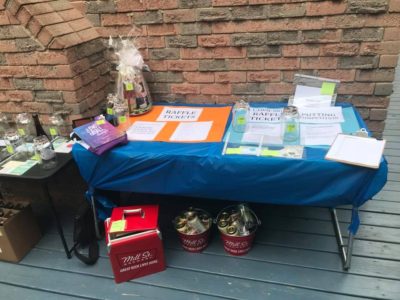 Rory Nisan used a raffle as a fund raising tool – Luke McEachern didn’t think the rules had been followed. He asked that Nisan’s election spending be audited and the Compliance Audit Committee said yes. There was also an Application for Compliance Audit of the Rory Nisan election spending report. The Compliance Audit Committee granted the request for an audit saying “there was reasonable grounds to proceed with an audit, based on the lack of information provided on the monetary and non-monetary contributions to the Raffle Event.”
Nisan and Williams were ward 3 candidates in the October municipal election. Nisan won.
Luke McEachern filed the request for a review of the Nissan spending siting the following:
Candidate solicited gifts for Raffle for fund raising purposes.
Receipts for gifts not accounted for.
Return of gifts not receipted.
The rules for compliance audits say:
 An elector who is entitled to vote in an election and believes on reasonable grounds that a Candidate and/or Registered Third Party has contravened a provision of the Act relating to election campaign finances is required to complete the application for Election Compliance Audit providing reasons and supporting documentation. An elector who is entitled to vote in an election and believes on reasonable grounds that a Candidate and/or Registered Third Party has contravened a provision of the Act relating to election campaign finances is required to complete the application for Election Compliance Audit providing reasons and supporting documentation.
Within 30 days after receiving the application, the Compliance Audit Committee will consider the application and determine if an audit is required or if the application is rejected.
The decision of the Committee regarding whether an audit is required or if the application is rejected, may be appealed to the Ontario Court of Justice within 15 days after the decision is made.
If the Committee grants the audit, the auditor will conduct the audit to determine if the Candidate or Registered Third Party has complied with the requirements of the Municipal Elections Act with regard to election campaign finances.
The auditor will provide a report to the Clerk, the Candidate or Registered Third Party and the Applicant.
The committee will consider the report within 30 days of receiving it and determines whether legal proceedings should be commenced against the Candidate or Registered Third Party.
The process proceeds. The Gazette awaits the outcome – as does the candidate.
The Gazette is also continuing with its investigation of the donation swap that took place between Ward 2 Councillor Lisa Kearns and Ward 3 candidate Rory Nisan. They each donated $1200 to the other’s election campaign.
Related news story.
Ward 3 candidate regrets the fund raising error

 By Pepper Parr By Pepper Parr
July 25th, 2019
BURLINGTON, ON
My friend Vince Fiorito, one of the best environmental advocates Burlington has, taught me that there is nothing that comes before the environment – not jobs, not the bank rate, not even who we elect as Prime Minister – without an environment that meets our needs – nothing else matters.
And, he adds, that environment is something we play a very large part in creating; given the climate changes we are going through now – it is clear that we have not done a very good job with some thinking that we are never going to be able to recover if we don’t do what has to be done before it is too late. The planet will go through another stage of extinctions. We have had three so far – the planet survived the creatures on it didn’t.
This time WE are the creatures on this planet.
That lesson – that the environment comes before everything, taught me something – that in every situation, organization or endeavour there are things that have to come first.
After publishing a report on the risks Burlington faces with its labour force the Fiorito lesson struck me.
The only thing that matters at city hall are the people who enter the buildings every day to work for the people that pay them.
Unfortunately those people do not seem to be able to pull together very well. And we aren’t paying them what other municipalities are prepared to pay them.
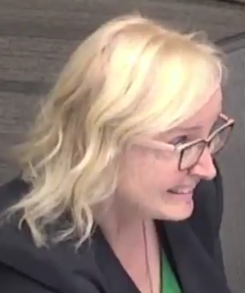 Director of Human Resources Laura Boyd In her report to city council Director of Human Resources Laura Boyd spoke of some of the feedback her department had received and added that:
“When the results were further analyzed, it became apparent that communication within the organization diminishes between hierarchical levels.
“Specifically, between the Burlington Leadership Team and the Supervisors/Manager level and then between the Supervisors/Managers level and their direct reports.”
No wonder we are in the mess we are in.
My question was: How long has Boyd known this? Did she send her message up the food chain to the city manager at the time? Did she alert the Mayor?
The Gazette has listened to Ms Boyd report to city council in the past – we never heard before what she had to say earlier this month.
Staff is what counts. It is their energy, their creativity and their willingness to put in that extra effort that makes a city work.
They aren’t putting in the energy apparently, partly because they are not being paid as well as their peers in other municipalities.
Have you ever seen a city staff member wearing a T shirt with the city logo? Not much pride in working for the city of Burlington.
In the past few days we have seen comments from people who once worked for the city. Some comments could be sour grapes. We’ve noticed that many of the people we got to know are no longer with the city.
A major change in the culture of the city’s work force and the way they are recognized is needed. That falls on the desk of the city manager.
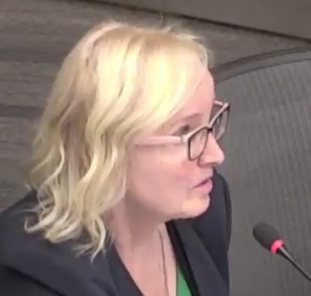 Laura Boyd – Has worked in one city department during her 29 year career. If we have the numbers right Ms Boyd has been with the city for 29 years – which suggests getting close if not eligible for retirement. All her work experience is with the one department – Human Resources – that too might be part of the problem.
In her report to Council Ms Boyd reports that something close to 20% of the leadership positions will see retirements in the near future.
That gives the city manager some room to find the people that are needed to bring the ship of state around and find more favourable winds to move it forward.
Related news story.
Troops are not happy.
Salt with Pepper is the musings, reflections and opinions of the publisher of the Burlington Gazette, an online newspaper that was formed in 2010 and is a member of the National Newsmedia Council.

 By Staff By Staff
July 25th, 2019
BURLINGTON, ON
Burlington Green has announced their 2019 Photo Contest. Simple to participate.

Take a picture of your favourite tree – send it in and wait for the results.
More detail – if that’s what you need:
1. Snap a photo of your favourite tree in Burlington. *If your photo includes a person(s), or address, you must have their permission to post the photo*
2. Email your photo as an attachment to michelle@burlingtongreen.org between July 8 to August 8 and tell us why it is your favourite tree (in no more than 50 words, please). Please include your full name in the email.
3. Look out for your photo on our Facebook page on August 9.
All entries will be posted publicly and open for voting. The photo with the most “likes” wins!
4. Share the post with your friends and ask them to “like” your photo for a better chance to win!
1. Participants must be residents of Halton Region.
2. All photos submitted to this contest will become the shared property of BurlingtonGreen in perpetuity. Photos used in the future for marketing purposes will include photo credits.
3. BurlingtonGreen will announce the winner on BurlingtonGreen’s Facebook page and website on August 20, with the winner also contacted by email.

 By Pepper Parr By Pepper Parr
July 23rd, 2019
BURLINGTON, ON
This is a seven part series on transit and how Burlington plans to get to the point where the public will take public transit to get to where they want to go in the city because it is cheaper, faster, more convenient and seen as the smart thing to do.
The world of municipalities is all about planning; trying to determine today what will have to be in place in two years, five years, perhaps as much as a decade away.
While the bureaucrats plan – the ground underneath them shifts.
Burlington is being pulled – kicking and screaming – into a world where they are not going to be able to get around all that well if they rely on their cars – the roads will be plugged – grid lock will be come as relevant as climate change.
Get used to using public transit.
The city is going to have to get itself to the point where it can offer public transit that people will want to take because it is convenient, reliable, reasonably priced and not something a large part of the city’s residents turn their nose up at.
But transit is going to have to meet the challenge if people expect to be able to get around the city.
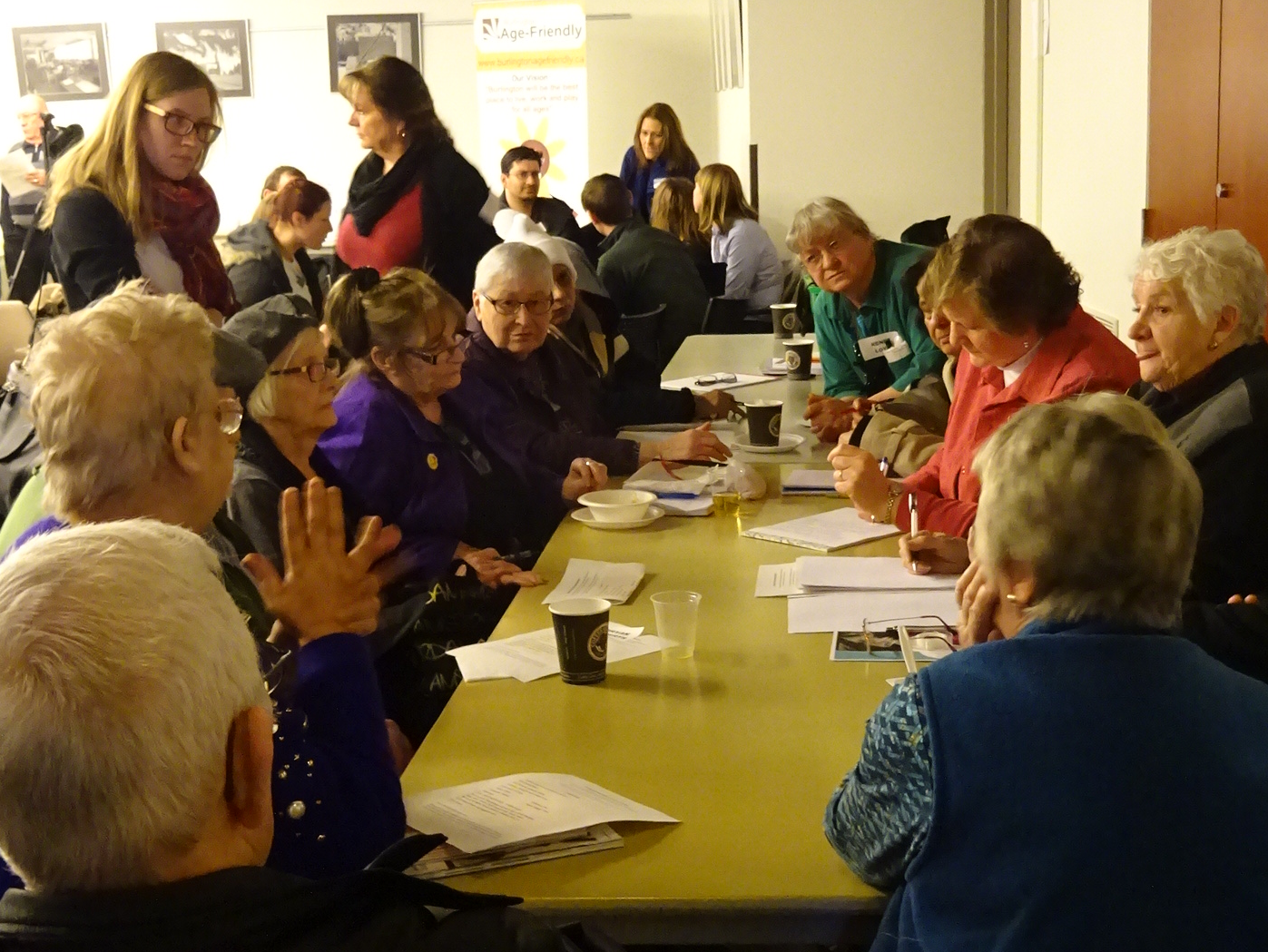 Senior citizens gather at a Bfast meeting to talk about the changes they need in transit. The 2024 target identified for Burlington represents a significant rate of growth over past
performance and above what Burlington Transit’s peers have achieved over the past five years. This will be difficult to achieve in a short period of time without significant investment in transit, a focus on customer service and culture change, including a change in how transit services are delivered.
A summary of the Transit Five-Year Business Plan peer review, vision and growth plan initiatives was presented to city council recently.
In the past, the quality of the leadership at Transit was a bit of a joke. The planning that was done could only be described as pathetic.
When the city went looking for new transit leadership they got lucky – Sue Connor who earned a stellar reputation for the changes she made at the Brampton Transit operation took the job offer Burlington made.
 Transit Director Sue Connor Ms Connor had to fight for every dollar the 2014-18 city council grudgingly gave her – but she persevered and prevailed.
Now she has gotten her teeth into what has to be done in Burlington to meet the change that is coming our way.
The Business Plan document will be based on data collected with a focus on the implementation of the growth plan initiatives, including their phasing and financial impacts.
Dillon Consulting, the people who did the background work has asked that Burlington Council provide feedback on these sections, so that any changes may be incorporated into the final Business Plan.
The 2020 – 2024 Burlington Transit Business Plan will guide the implementation of transit service improvements over the next five years. The Business Plan starts with a policy framework that defines a clear direction for Burlington Transit, and clear steps on how to get there.
It is important to note that a Business Plan does not provide details of service or operational planning. The primary purpose of the plan is to ensure individual strategies, projects and activities are aligned and
contributing to the Burlington Transit’s vision and policy objectives. This includes prioritizing and staging key decisions to fit within the City’s financial guidelines.
The Business Plan is also an important communication tool for Burlington Transit that will clearly set out steps required to move towards the long-term direction of the City. Over the next five-years, the Business Plan will form the guiding document in which all other operational decisions and financial budgets should be built around.
A key focus of the business plan is to identify the strategies and resources required to meet transit ridership growth targets. Ridership growth objectives for Burlington were identified in the 2011 Halton Region Transportation Master Plan, which targets a morning peak period internal transit mode share of 13.4 percent within the City of Burlington by 2031.
This represents a significant growth from the 4.6 percent transit mode share that is forecasted to be achieved by the end of 2019 (a 216 % increase in ridership, from 3,209,091 annual rides in 2019 to 10,763,637 annual rides in 2031).
That is an astounding number, there is no sense as to how it can be reached – Connor has set it out as what will be needed if objectives are to be met.
Over the five year life of this business plan, transit mode share is targeted to reach 8.3 percent by 2024, translating to 6,356,818 annual rides (a 98 percent growth in ridership from 2019; or 19.6 percent per year).
To put this into context, over the past five years, Burlington Transit’s ridership growth averaged
1.9 percent per year, while other systems in Burlington Transit’s peer group averaged 4.3 percent per year.
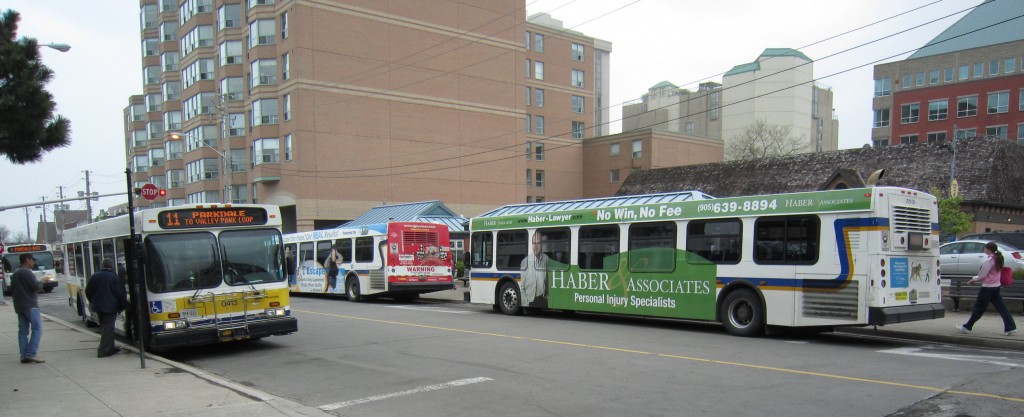 If there was ever a place to locate a transit terminal – that would be John Street where the only terminal in the city is now located. How will this terminal handle the planned increase in buses? The 2024 target identified for Burlington represents a significant rate of growth over past performance and above what Burlington Transit’s peers have achieved over the past five years.
This will be difficult to achieve in a short period of time without significant investment in transit, a focus on customer service and culture change, including a change in how transit services are delivered.
As illustrated in Table 1, the ridership growth target will move Burlington Transit ahead of many of its peers and in line with peer systems that have U-Pass agreements with post-secondary institutions (e.g. Kingston Transit, Guelph Transit and St. Catharines Transit). This suggests that the growth strategy should not only focus on supply-based solutions (e.g. increasing service levels), but also on solutions that influence demand.
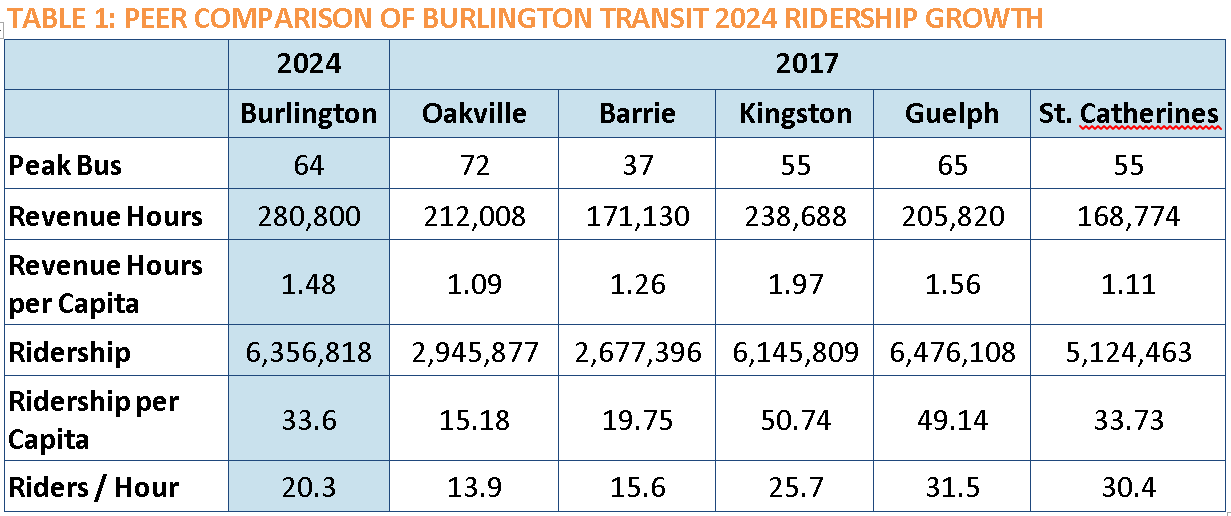
While population growth will also help grow ridership, Burlington’s population is only projected to grow by 3.7 percent by 20311.
Between 2019 and 2024, the population is projected to grow by 3,259 people (from 185,911 in 2019 to 189,170 in 2024). If the existing trip rate (boardings per capita) is applied to new residents over this period, this would only result in 56,255 new rides (1.8 percent of the ridership growth target) being attributed to new residents.
This means that to achieve this ridership target, existing and new residents will need to ride transit much more, creating a greater culture of transit use in the city.
Service Hour and Fleet Investment (2020 – 2024)
To accommodate the planned growth in ridership, Burlington will need to invest in the level of service provided to accommodate both an increased demand for service and to change travel behaviour. This will require an increase in the amount of service and the fleet required to deliver the service.
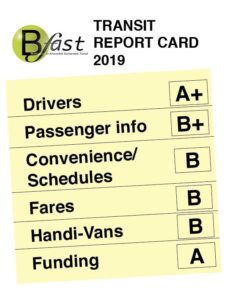 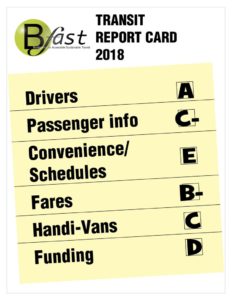 The City of Burlington Development Charges Transit Background Study (2019) identifies that Burlington Transit’s fleet will need to grow by 38 vehicles between 2019 and 2028 to meet transit mode share target. Phased in over the five-year life of this business plan, this represents a growth in 19 vehicles by 2024 (from 60 to 79). The City of Burlington Development Charges Transit Background Study (2019) identifies that Burlington Transit’s fleet will need to grow by 38 vehicles between 2019 and 2028 to meet transit mode share target. Phased in over the five-year life of this business plan, this represents a growth in 19 vehicles by 2024 (from 60 to 79).
Service hours will also need to grow to reach the mode share target. Work by Burlington Transit to support the Development Charges Study estimated that an investment in 100,800 annual revenue service hours is required over the next five years. This represents a 56 percent growth in service levels, which is a little lower than the 66 percent ridership growth, recognizing that ridership growth can lag behind investment by two to three years. The projected fleet, service hour and utilization growth is detailed in Table 2. Ridership numbers were calculated based on achieving Burlington Transit’s 13.37 percent mode share target in 2031, based on the ridership figures used in the Development Charges Study. These targets were used as a guide to determine the growth strategy for transit.
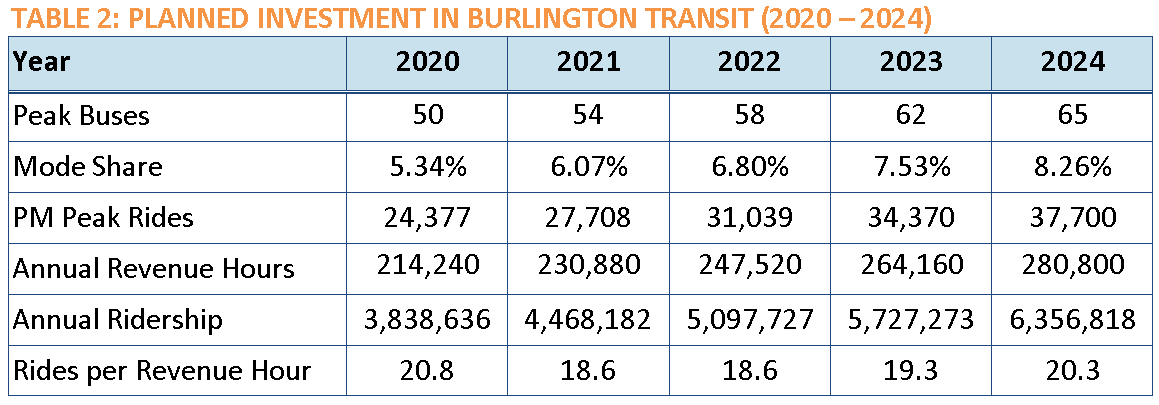
One of the primary purposes of a business plan is to focus actions taken by an organization so they are aligned with the vision, goals and strategies directions of a system. Burlington Transit has a mandate to significantly expand ridership in line with the mode share targets identified in the 2011 Halton Transportation Master Plan.
Forecast ridership is targeted to increase from 3,209,091 trips in 2019 to 6,356,818 trips by 2024. To achieve this growth target, Burlington Transit must provide mobility to residents, employees and visitors of the city. In doing so, Burlington Transit must:
• be Customer-Focused in every aspect of how service is delivered
• be Forward-Thinking in how services are planned and delivered
• be Business-Minded and aligned with municipal directions
This has become a litany for the people over at the transit offices where staff are pumped, engaged and know they have a leader who is going to move mountains if that’s what it takes to make transit work.
What a welcome change.

 By Pepper Parr By Pepper Parr
July 23rd, 2019
BURLINGTON, ON
It was the best offer he was going to get, probably the only offer – but he did convince the lady to let us see what she has in the way of pipes.
Mayor Marianne Meed Ward took James Burchill up on his challenge that they go for a drive in his Smart Car to determine if the training as an opera singer Meed Ward said she had taken amounted to anything.
 She was breaking his heart. It is a very short clip – but she can sing. There is a short ad before the voices are heard – you can skip over that.
Check out the two minute clip.
In a note on her Facebook page, the Mayor said: “It was a great time, and you are a fab duet partner. Next time you get to pick the song (yes there will be a ‘next time’)

 By Pepper Parr By Pepper Parr
July 23rd, 2019
BURLINGTON, ON
In his 33 years of puddle jumping Scott Stewart went from Peel Region to Mississauga, to Brampton, then Hamilton, then Burlington, and on to Guelph where they appointed him the Chief Administrative Officer – a job that eluded him for far too long in Burlington.
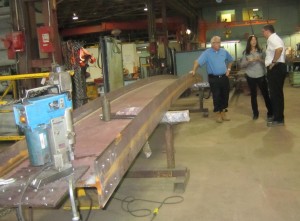 General Manager Scott Stewart with Deb Franke of AJ Braun and Craig Stevens discuss the welding of beams for the Pier. Stewart was the General Manager who pulled together the team that ensured the city got it right the second time around. Scott was always a hands on leader. He would spot talent that others didn’t see and grow it, groom it and nurture that talent to the point where it could lead.
Burlington’s city council turned Scott Stewart down twice – he took the hint and went north to Guelph – a city he likes, partly because they own a railway line that Stewart had turned into a competitive advantage for the city.
 Stewart will wear the sweater to the office the day the Maple Leafs win the Stanley Cup. Leadership positions within the municipal sector are attained by moving from location to location – taking the experience gained at one and applying it at another. Burlington lost an opportunity when it chose James Ridge over Scott Stewart – look where that got us. Well, it did rid the city of an under-performing council.
As the Chief Administrative Officer Stewart just might have to move from Burlington, a city where he has deep roots.
Salt with Pepper is the musings, reflections and opinions of the publisher of the Burlington Gazette, an online newspaper that was formed in 2010 and is a member of the National Newsmedia Council.

 By Pepper Parr By Pepper Parr
July 24th, 2019
BURLINGTON, ON
Ashley Worobec, a Burlington based sports chiropractor, is training for the New York marathon on November 3rd; as she puts it “15 weeks from yesterday”.
Ashley is about four weeks into this training cycle. She is very much a half-marathoner and 10k runner and didn’t start a training plan with no fitness under her belt. “I was comfortably running 5-10km a few times per week before training “officially” kicked off mid-June.
 Will Ashley Worobec go through a pair of running shoes while she trains? “I run 4-5 times per week, with one long run per week that will gradually increase in length; this past weekend was 18km with a 37C humidex!
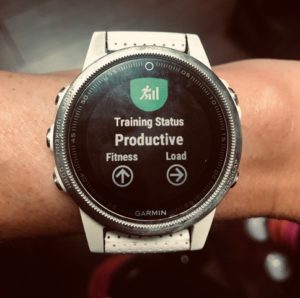 All the training data she needs is on her wrist. “My longest training run will be in the 36-38km range, and a full marathon is 42.2km- the marathon is unique in this respect, as it’s the only race that athletes go into not having completed the full distance in training ahead of time- the reality is that the risk of injury just gets too high when you get up into those super long runs, so race-day adrenaline and sheer willpower will get me through the last few kms of the marathon.
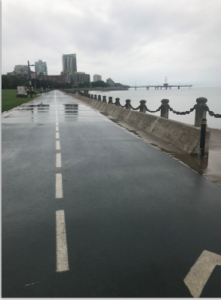 The Naval Promenade along the edge of the lake in Spencer Smith Park is ground zero for much of her training – rain or shine Ashley has run five full marathons in the past, including the Boston marathon in 2003. However, she I hasn’t run a full marathon since 2007, and “in that 12-year gap I’ve had two children and have a lot less free time now! I do all of my runs very early in the morning (5:30am meetups with my running group) and that’s how I make it work.”
A lot of people have been asking me how I train through the summer heat, and this is my advice:
1- focus on hydration the day before your run so that you’re hydrated heading into it.
2- bring water with you, or arrange to have access to water fountains along your route
3- start early to beat as much of the heat as you can
4- be mindful of your route and keep in mind that shaded areas, or areas along the lake (with a lake breeze!) are typically cooler
5- don’t worry about your pace per kilometer, just run by feel and listen to your body.
Ashley will be checking in with the Gazette every week. We will follow her on run day as well.

|
|
 By Pepper Parr
By Pepper Parr




 Since TechPlace launched in 2017 it has hosted over 10,000 visitors, 200 events, attracted 13 LaunchPad companies, creating a strong business attraction brand and value proposition for Burlington. Results since inception are:
Since TechPlace launched in 2017 it has hosted over 10,000 visitors, 200 events, attracted 13 LaunchPad companies, creating a strong business attraction brand and value proposition for Burlington. Results since inception are:














 The general rule is that dynamic stretching (stretching that involves movement, like walking lunges, marching and leg swings) is best to be done before activity, whereas static stretching (stretch and hold movements, like the downward dog seen in my photo) is best to be done after activity.
The general rule is that dynamic stretching (stretching that involves movement, like walking lunges, marching and leg swings) is best to be done before activity, whereas static stretching (stretch and hold movements, like the downward dog seen in my photo) is best to be done after activity. I am also really trying to focus on sleep, and that 9 hours you see on my Garmin reading happened the night after a 20km run (my longest run to date in this training plan).
I am also really trying to focus on sleep, and that 9 hours you see on my Garmin reading happened the night after a 20km run (my longest run to date in this training plan).

















 We are the WeLoveBurlington Advocacy Group. We are distinctly ‘grass roots’ and non-partisan. We advocate on a broad range of issues that affect the City of Burlington and its citizens.
We are the WeLoveBurlington Advocacy Group. We are distinctly ‘grass roots’ and non-partisan. We advocate on a broad range of issues that affect the City of Burlington and its citizens.

 “Small and medium-sized businesses in our province will be eligible to receive funding of up to 25 percent of the cost of projects that will make their businesses more productive and competitive as they reduce energy use, save money, and cut greenhouse gas pollution. $72.4 million has been earmarked for Ontario for 2019-20 through the Climate Action Incentive Fund.
“Small and medium-sized businesses in our province will be eligible to receive funding of up to 25 percent of the cost of projects that will make their businesses more productive and competitive as they reduce energy use, save money, and cut greenhouse gas pollution. $72.4 million has been earmarked for Ontario for 2019-20 through the Climate Action Incentive Fund.


















 The new Canada Food Guide is a science-based document which has been extensively researched and was crafted following wide ranging consultations across our society. It has taken a decade for the officials responsible to muster the courage to come forward, break with tradition, and tell it like it is. The guide is signalling that it’s time to cut back on meat and milk and salt and sugar… and fast food.
The new Canada Food Guide is a science-based document which has been extensively researched and was crafted following wide ranging consultations across our society. It has taken a decade for the officials responsible to muster the courage to come forward, break with tradition, and tell it like it is. The guide is signalling that it’s time to cut back on meat and milk and salt and sugar… and fast food. Ray Rivers writes regularly on both federal and provincial politics, applying his more than 25 years as a federal bureaucrat to his thinking. Rivers was once a candidate for provincial office in Burlington. He was the founder of the Burlington citizen committee on sustainability at a time when climate warming was a hotly debated subject. Ray has a post graduate degree in economics that he earned at the University of Ottawa. Tweet @rayzrivers
Ray Rivers writes regularly on both federal and provincial politics, applying his more than 25 years as a federal bureaucrat to his thinking. Rivers was once a candidate for provincial office in Burlington. He was the founder of the Burlington citizen committee on sustainability at a time when climate warming was a hotly debated subject. Ray has a post graduate degree in economics that he earned at the University of Ottawa. Tweet @rayzrivers






 An elector who is entitled to vote in an election and believes on reasonable grounds that a Candidate and/or Registered Third Party has contravened a provision of the Act relating to election campaign finances is required to complete the application for Election Compliance Audit providing reasons and supporting documentation.
An elector who is entitled to vote in an election and believes on reasonable grounds that a Candidate and/or Registered Third Party has contravened a provision of the Act relating to election campaign finances is required to complete the application for Election Compliance Audit providing reasons and supporting documentation.







 The City of Burlington Development Charges Transit Background Study (2019) identifies that Burlington Transit’s fleet will need to grow by 38 vehicles between 2019 and 2028 to meet transit mode share target. Phased in over the five-year life of this business plan, this represents a growth in 19 vehicles by 2024 (from 60 to 79).
The City of Burlington Development Charges Transit Background Study (2019) identifies that Burlington Transit’s fleet will need to grow by 38 vehicles between 2019 and 2028 to meet transit mode share target. Phased in over the five-year life of this business plan, this represents a growth in 19 vehicles by 2024 (from 60 to 79).









